DNA Replication, Cell Division, Gene Mutation
1/111
Earn XP
Description and Tags
Topics: DNA replication, mitosis, meiosis, mutations
Name | Mastery | Learn | Test | Matching | Spaced |
|---|
No study sessions yet.
112 Terms
DNA replicates itselfs so that ….
every new cell receives a complete copy of the genetic code.
DNA replication is a necessary …
preliminary for cell division, before MITOSIS for growth and repair and before 1st division of MEIOSIS so gamete get copy of genetic material in body cells.
DNA replication steps
Unzips DNA
Complementary base pairs
Join nucleotides together
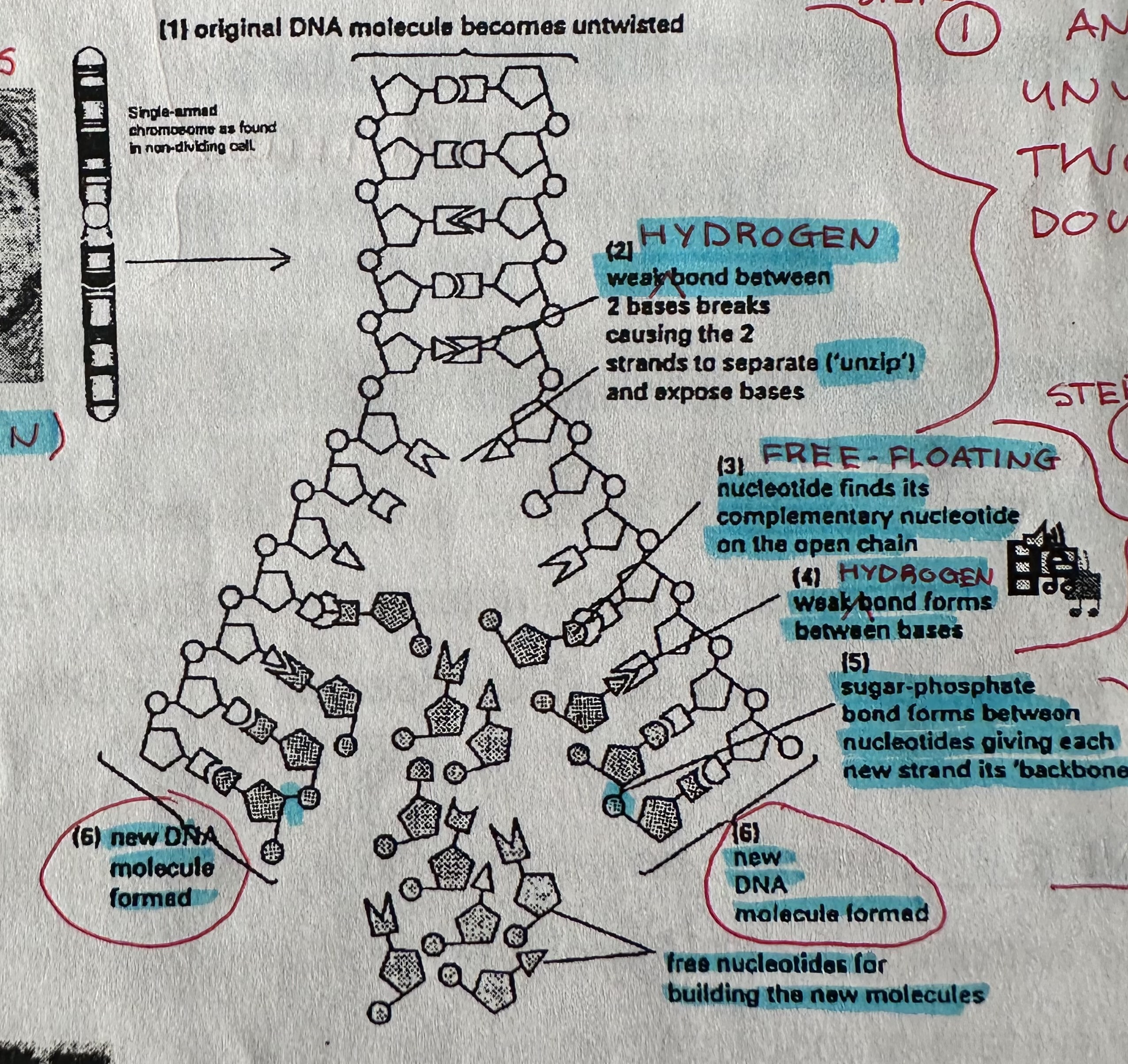
Unzips DNA
An enzyme unwinds and unzips the strand of DNA double helix.
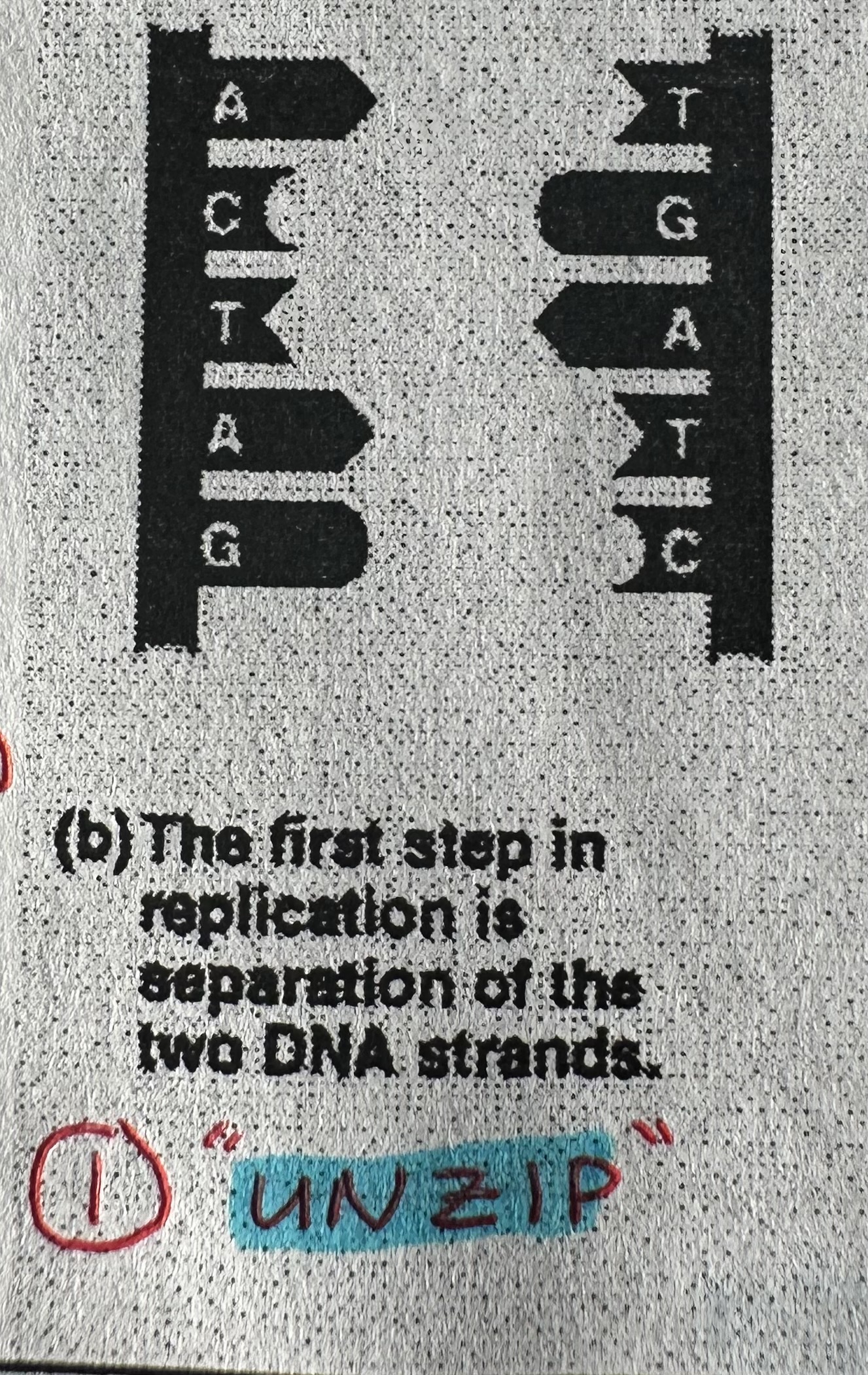
Complementary base pairs
Free-floating DNA nucleotide complementary base pairs with the “unzipped” original DNA.
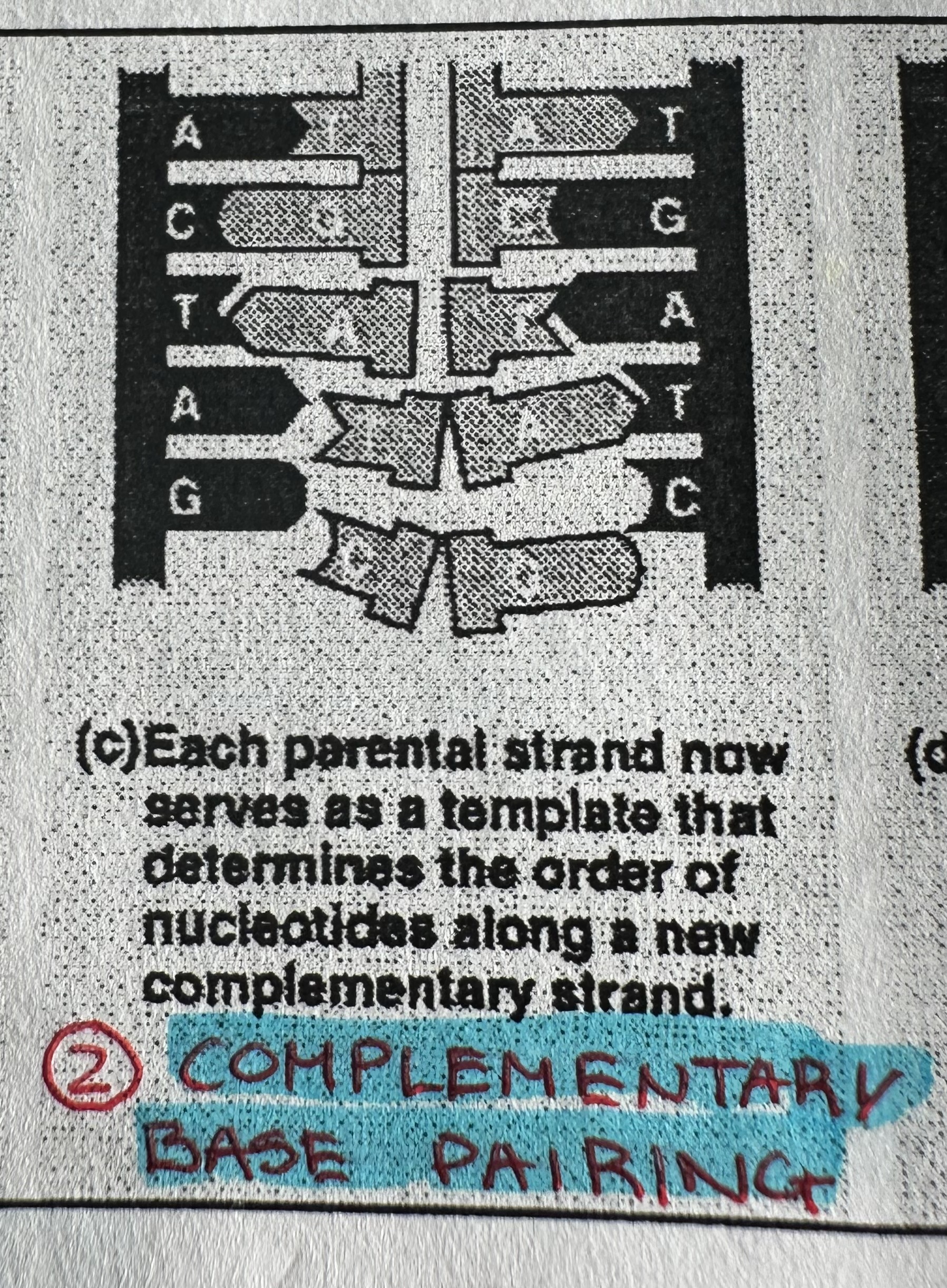
Joins nucleotides together
An enzyme joins the NEW DNA nucleotides together forming the sugar-phosphate “backbone”
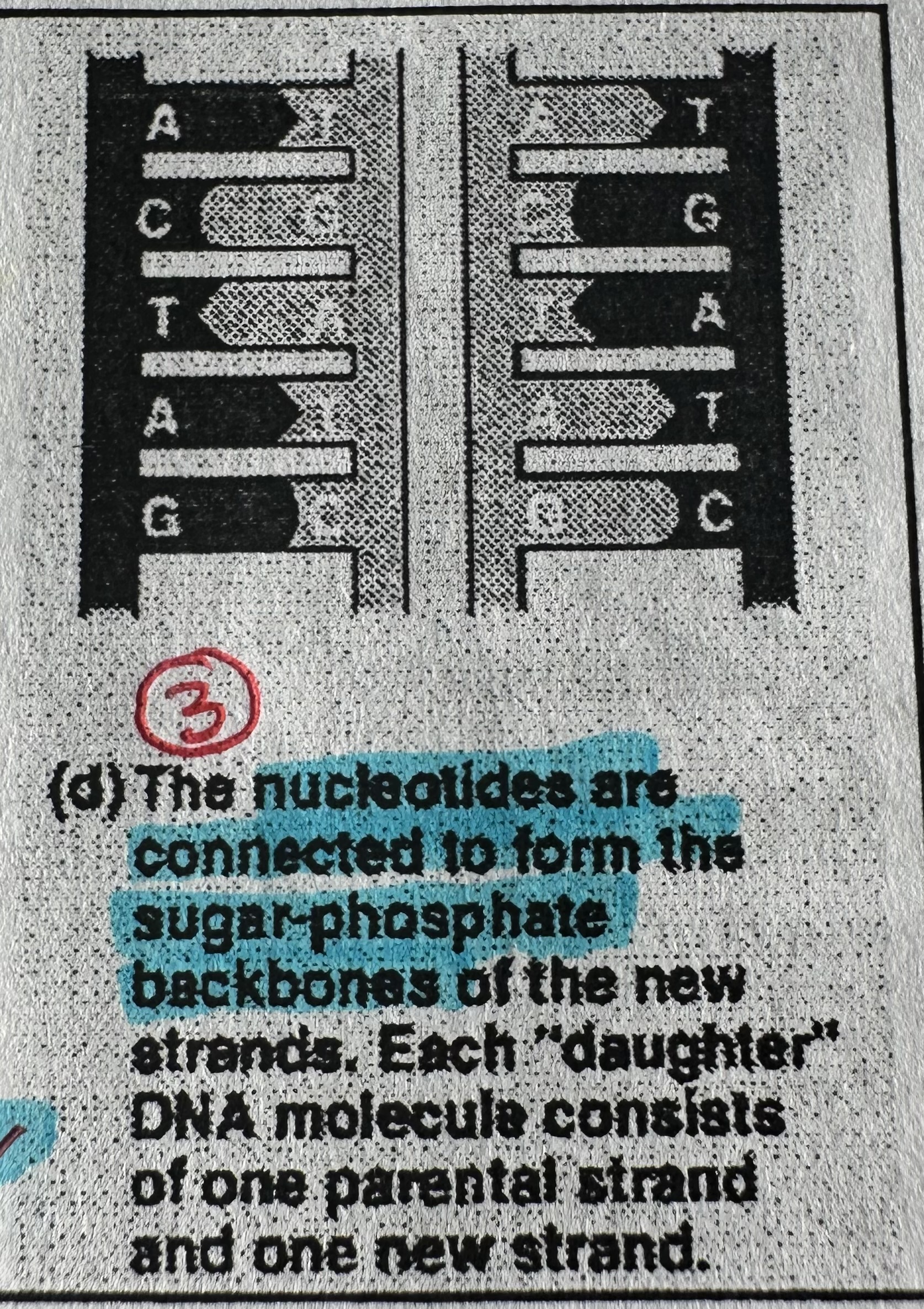
After DNA replication
end up with TWO IDENTICAL strands of DNA. Can now SUPER COIL into a CHROMOSOME and enter CELL DIVISION.
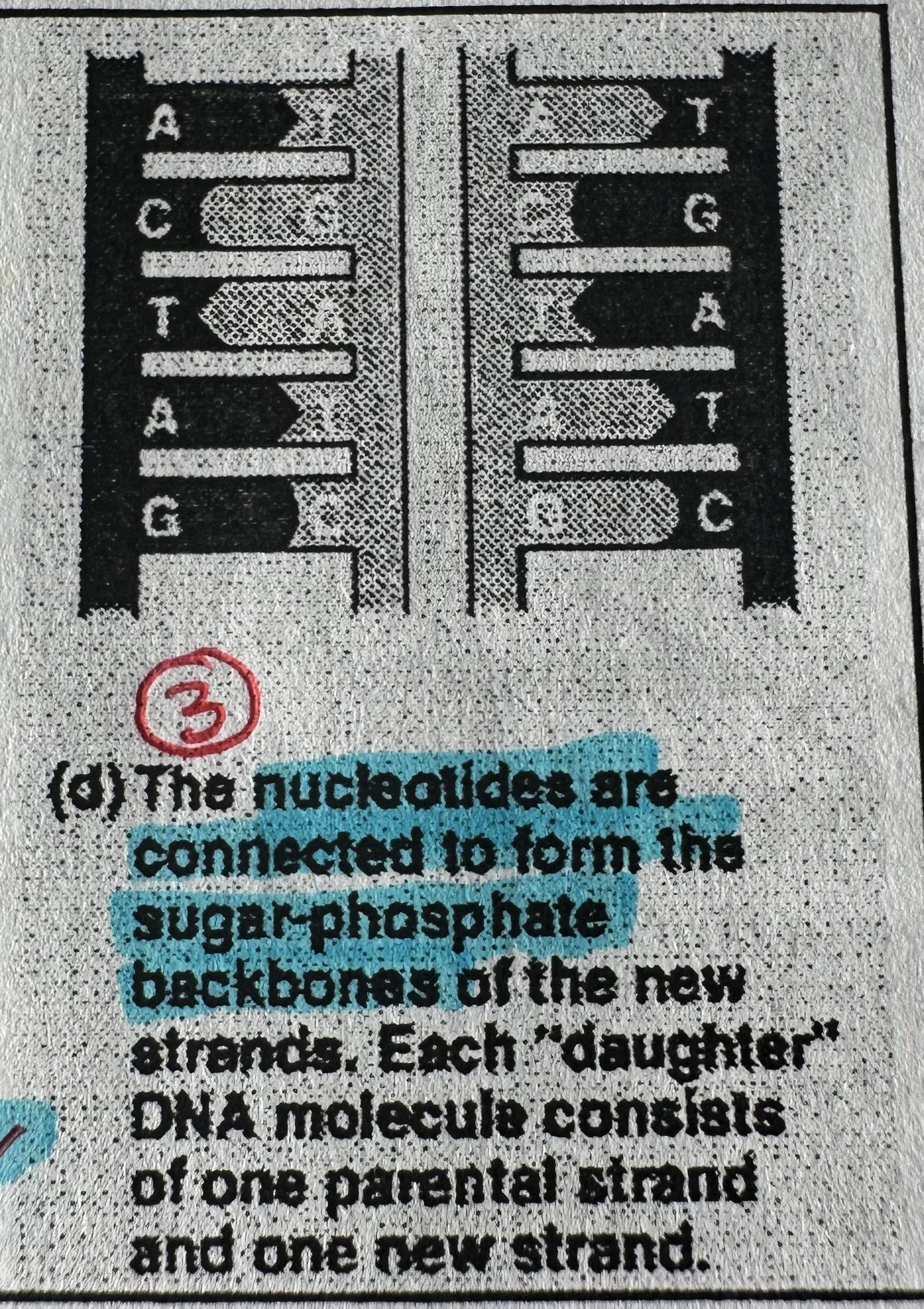
Chromosomes
Rod-shaped bodies of DNA and HISTONE PROTEINS, clearly visible, only appears during cell division.

Chromatin
Long, filamentous, thread-like, DNA wrapped around HISTONE proteins, occurs in between cell division (non dividing cell)
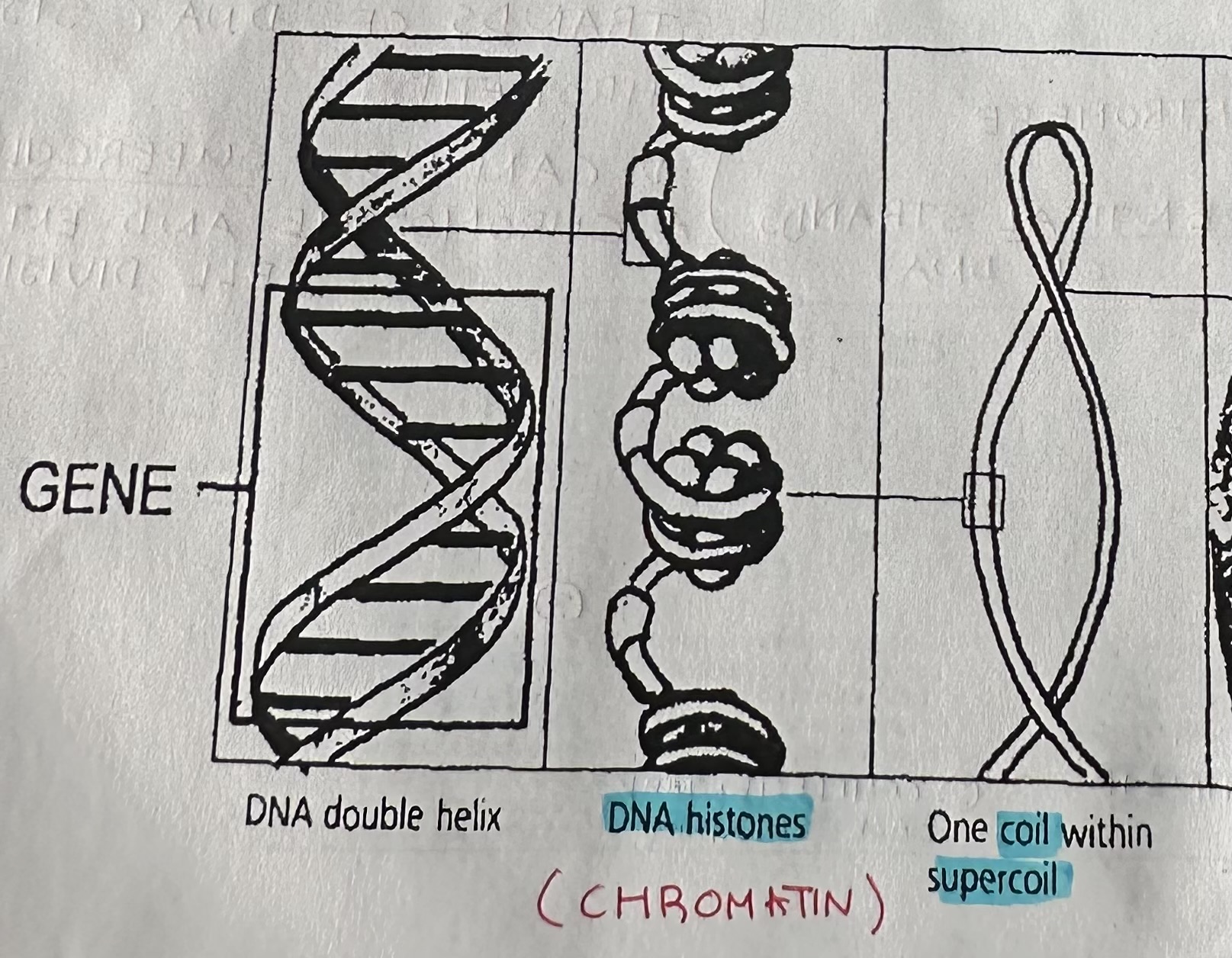
Chromosomes function
carry genetic information from one generation of cells to the next. Also prevents tangling
Histone proteins
ball-shaped proteins that are responsible for packaging DNA so that it can fit inside the nucleus, it with DNA can supercoil and shorten many times into CHROMOSOMES.
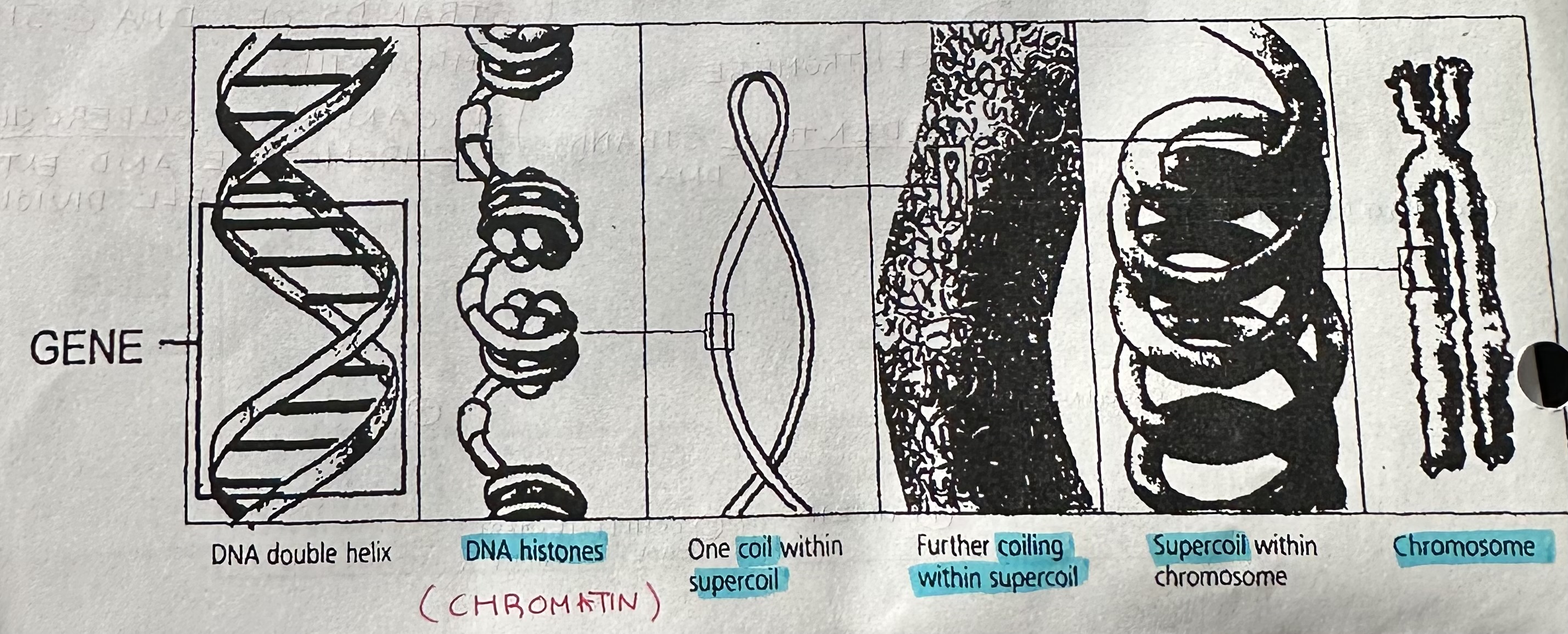
Human cells contain
most of the time contains 46 strands of chromatin during non-division. 46 chromosomes during division
Chromosome numbers
Cells of a species contain a specific number of chromosome e.g humans have 46 chromosomes (cell division), chromosome number (2n) = 46.
Homologous pairs
2 chromosomes that have similar size, shape and banding. One MATERNAL from mom, and one PATERNAL from dad.
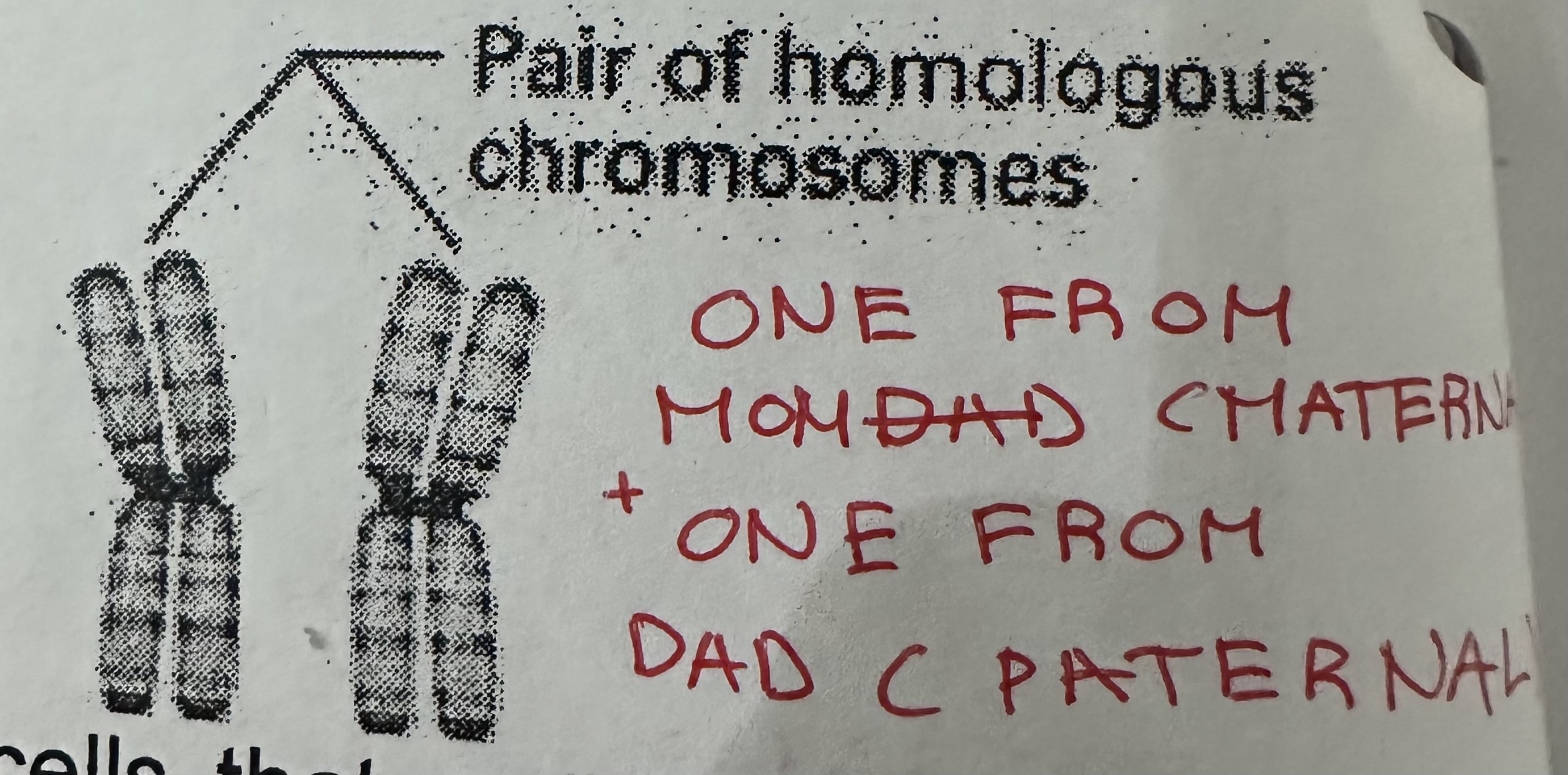
Karyotypes
Prepared from nuclei of white blood cells that are “frozen” at metaphase stage of mitosis. A photograph of the chromosomes is cut and rearranged on a grid in homologous pairs.
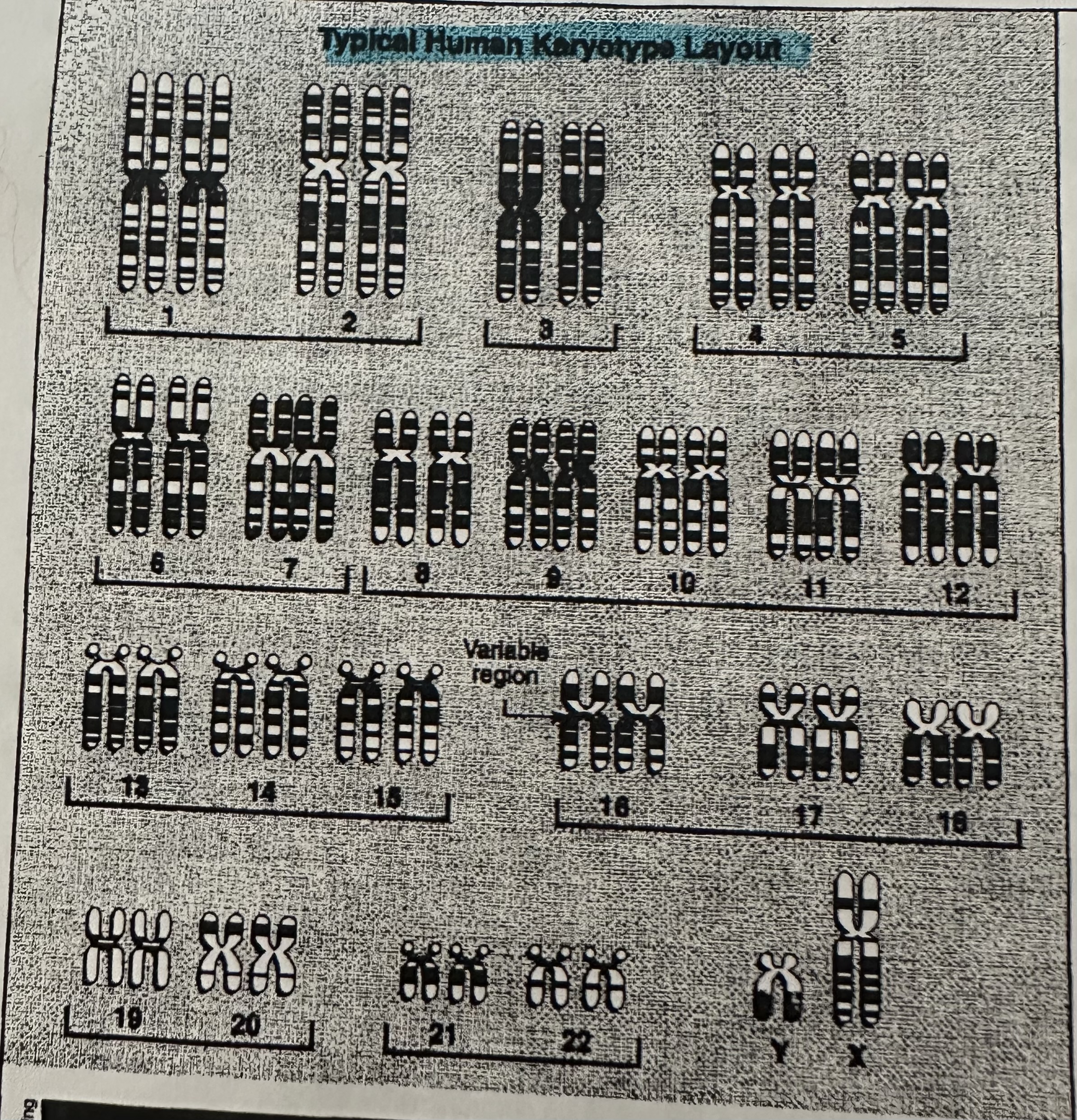
Sex chromosomes
X and Y, bottom right in the a karyotype
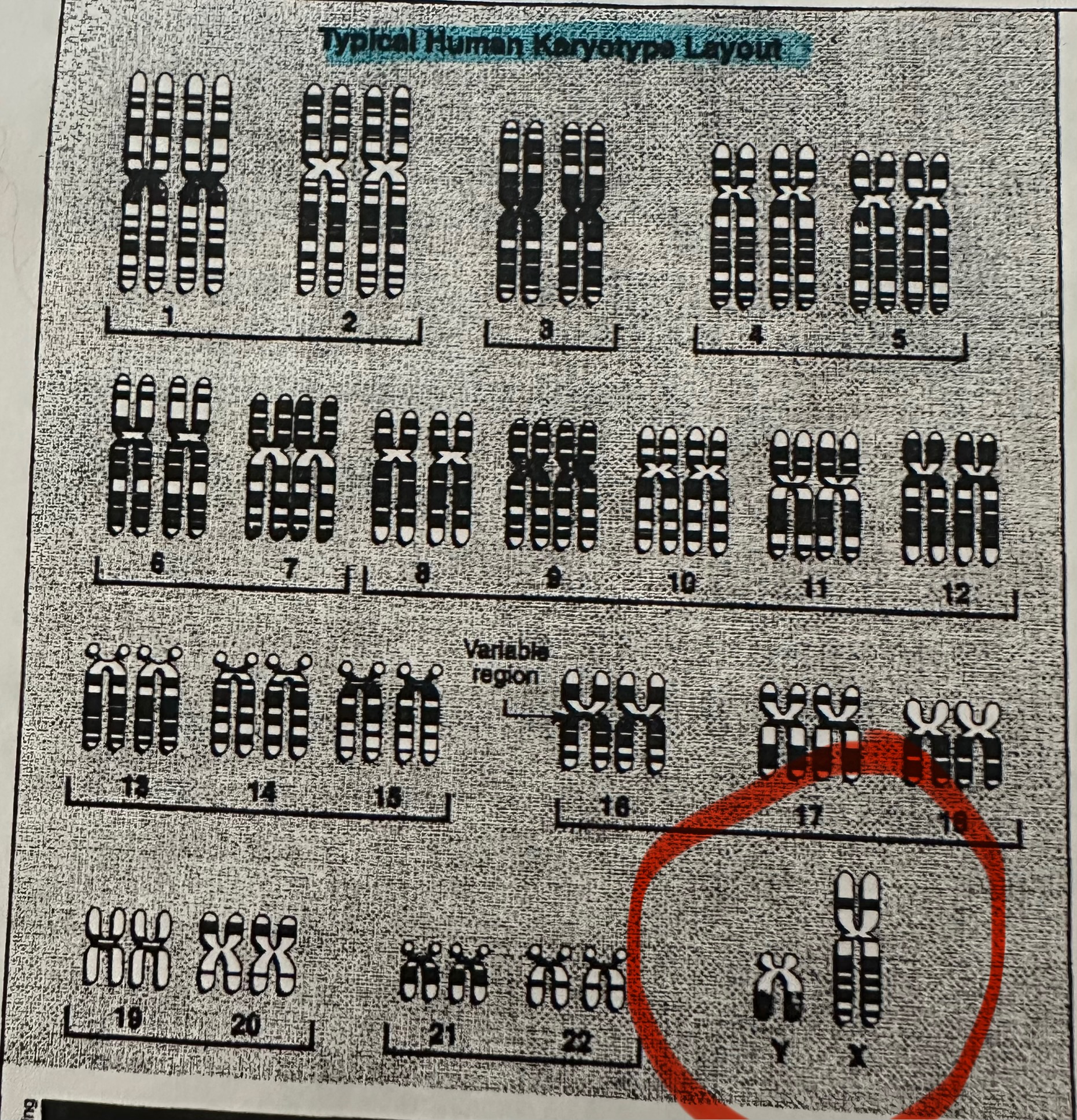
Autosomes
44 other chromosomes in the karyotype.

Chromosome structure
Contain two SISTER CHROMATIDS that are identical attached at an area called the CENTROMERE.

Centromere
usually located near the middle of the chromatids, some lie near the ends.
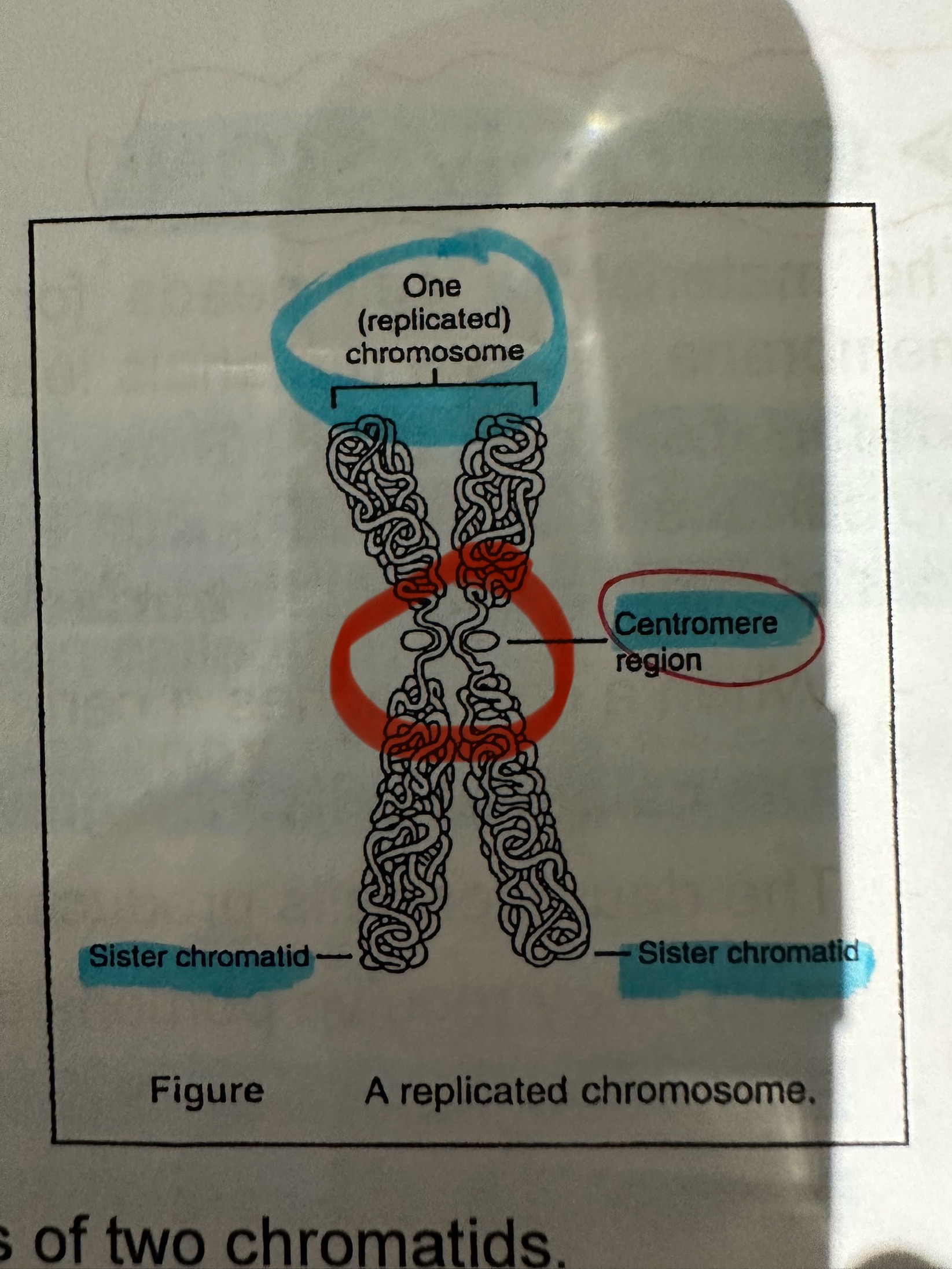
Cell division
When cells reach a certain size, it divides to maintain a workable surface area to volume ratio, into TWO DAUGHTER cells. They then also do the same.
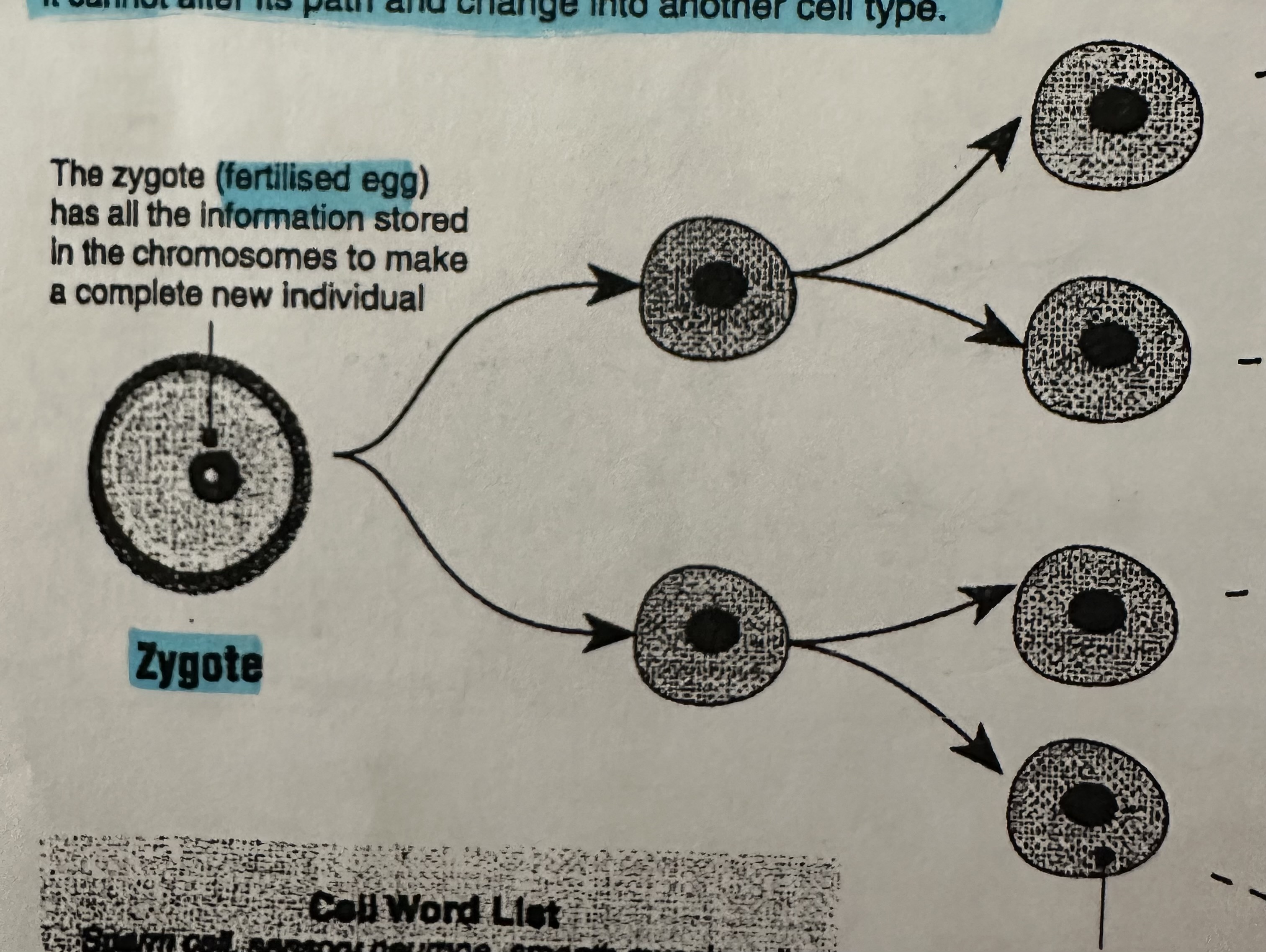
Daughter cell
Must be identical to original PARENT CELL. Receive portions of the cytoplasm and organelles of parent cell and exact copy of the hereditary information (DNA) of the parent cell from DNA replication.
Cellular differentiation
process of cells in organs and tissues embryo becoming more modified and specialized for specific functions when they take form. By the turning on and off of genes. Once the fate of a cell has been determined, it cannot alter its path and change into another cell type.
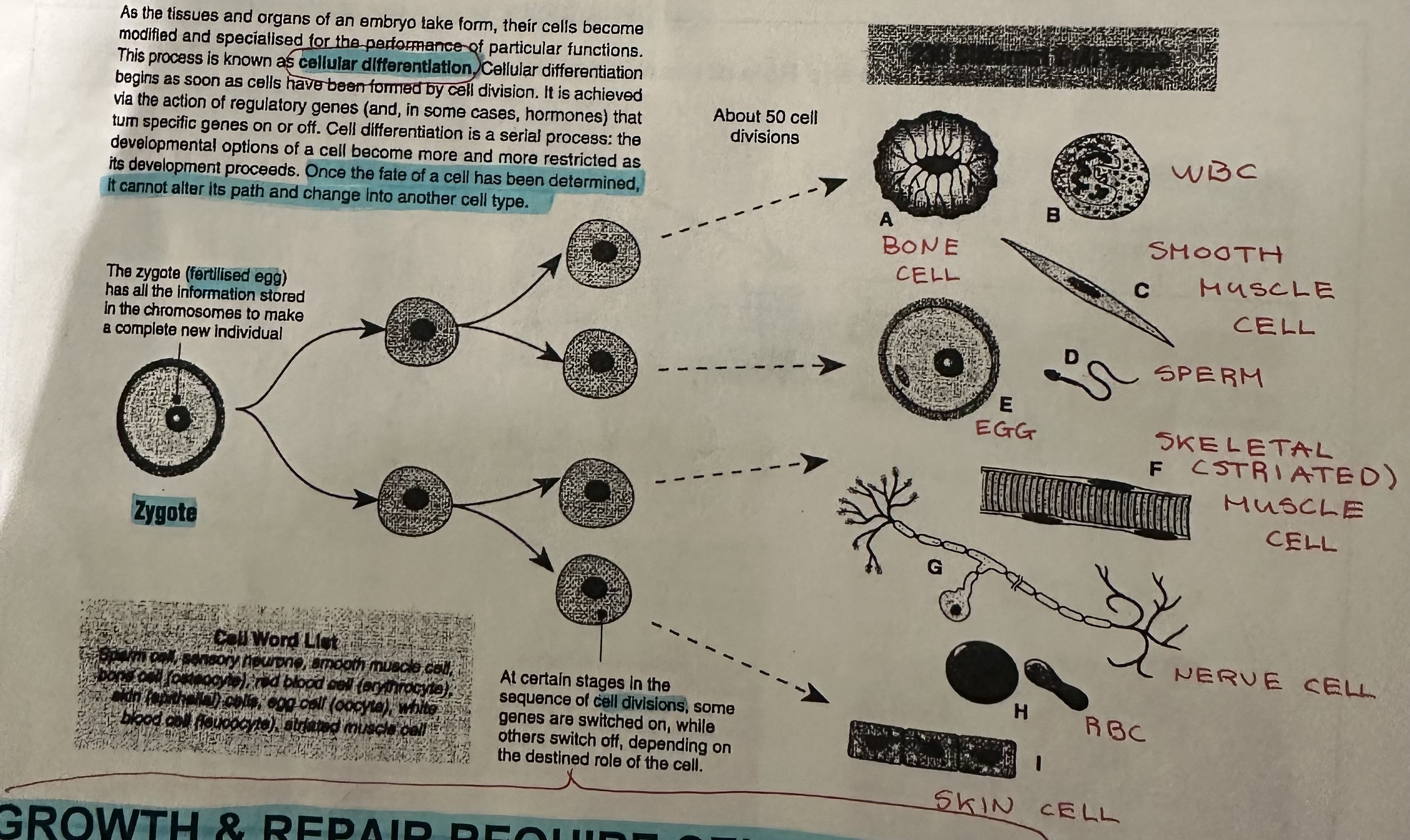
Growth and repair require cell division
multicelluar organisms grow by increasing number of cells through cell division.
Cell division also produces new cells that replace worn out damaged cells.
Time frame of cell division
Human cells require 18-22 hours to divide. Many cells like skin and epithelial intestine cells divide while some cells like nerve cells and muscles do not.
Mitosis
Division of the nucleus. Results in each daughter cell receiving an exact copy of the parent cell chromosomes and same number of chromosomes too.
Cell cycle
sequence of cell growth and cell division. Between beginning of one mitosis and the beginning of next mitosis. Cells complete cell cycle at different times e.g epithelial intestine cells take 6 to 12 hours, while nerve and muscles cells do not divide when developed.
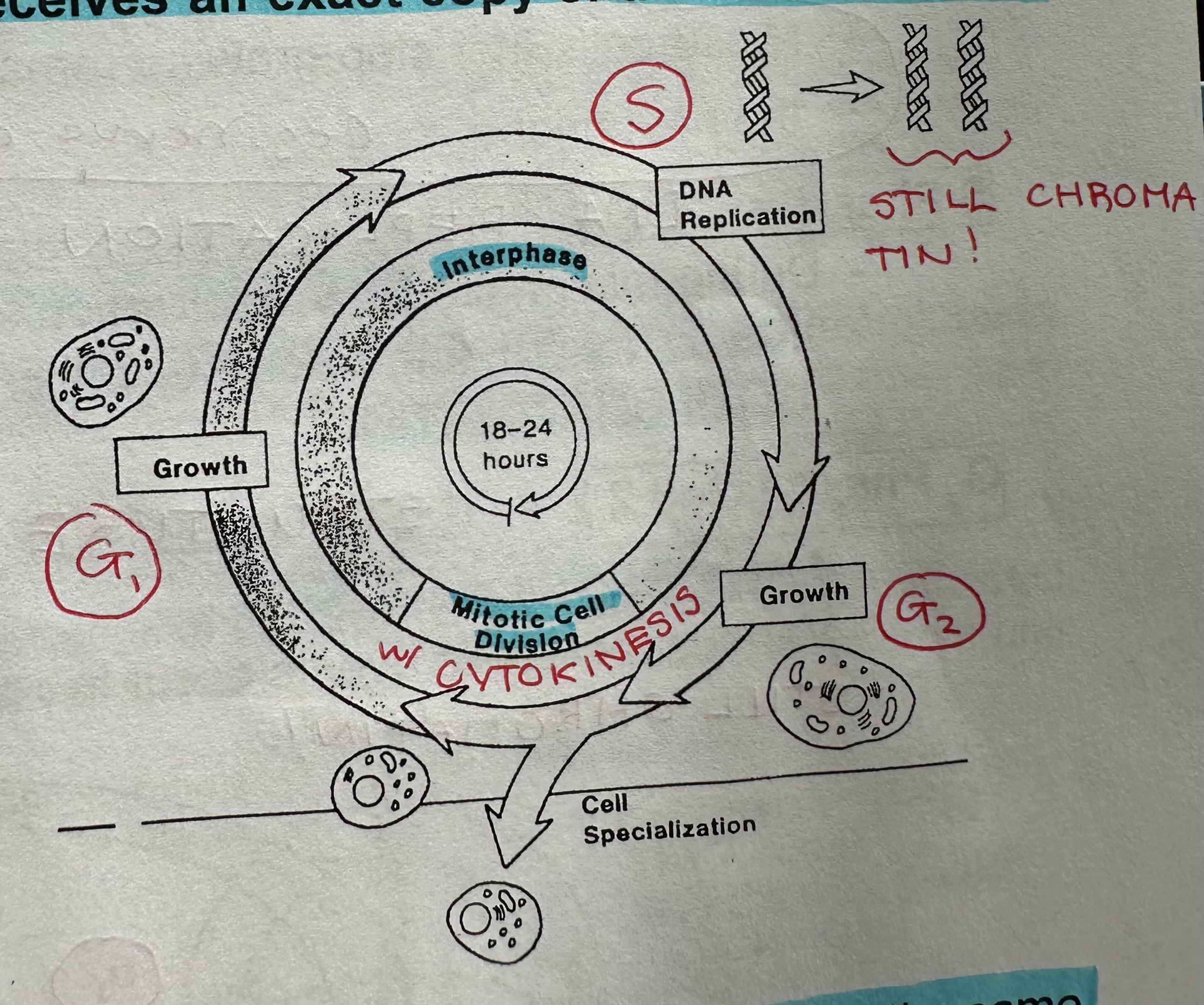
Interphase
Period in cell cycle BETWEEN CELL DIVISIONS (Mitosis). Active period in cell’s life DNA replication, cell parts are made, and most of cell growth are during interphase.
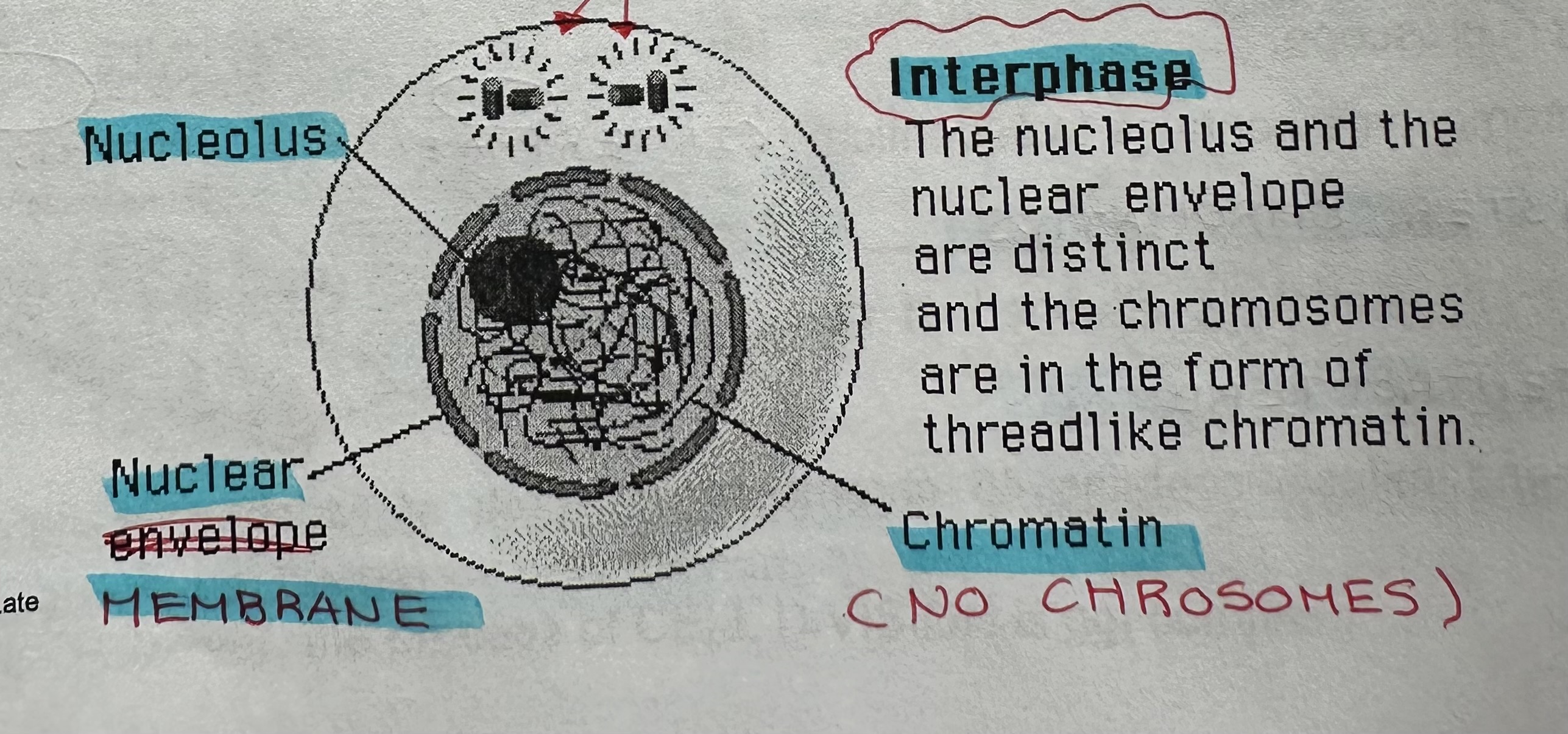
Interphase cont.
can be long ( abt 90% of cell’s lifetime), DNA & histone proteins appear as CHROMATIN.
Interphase three phases
G1 Phase (Gap 1) → S Phase → G2 Phase
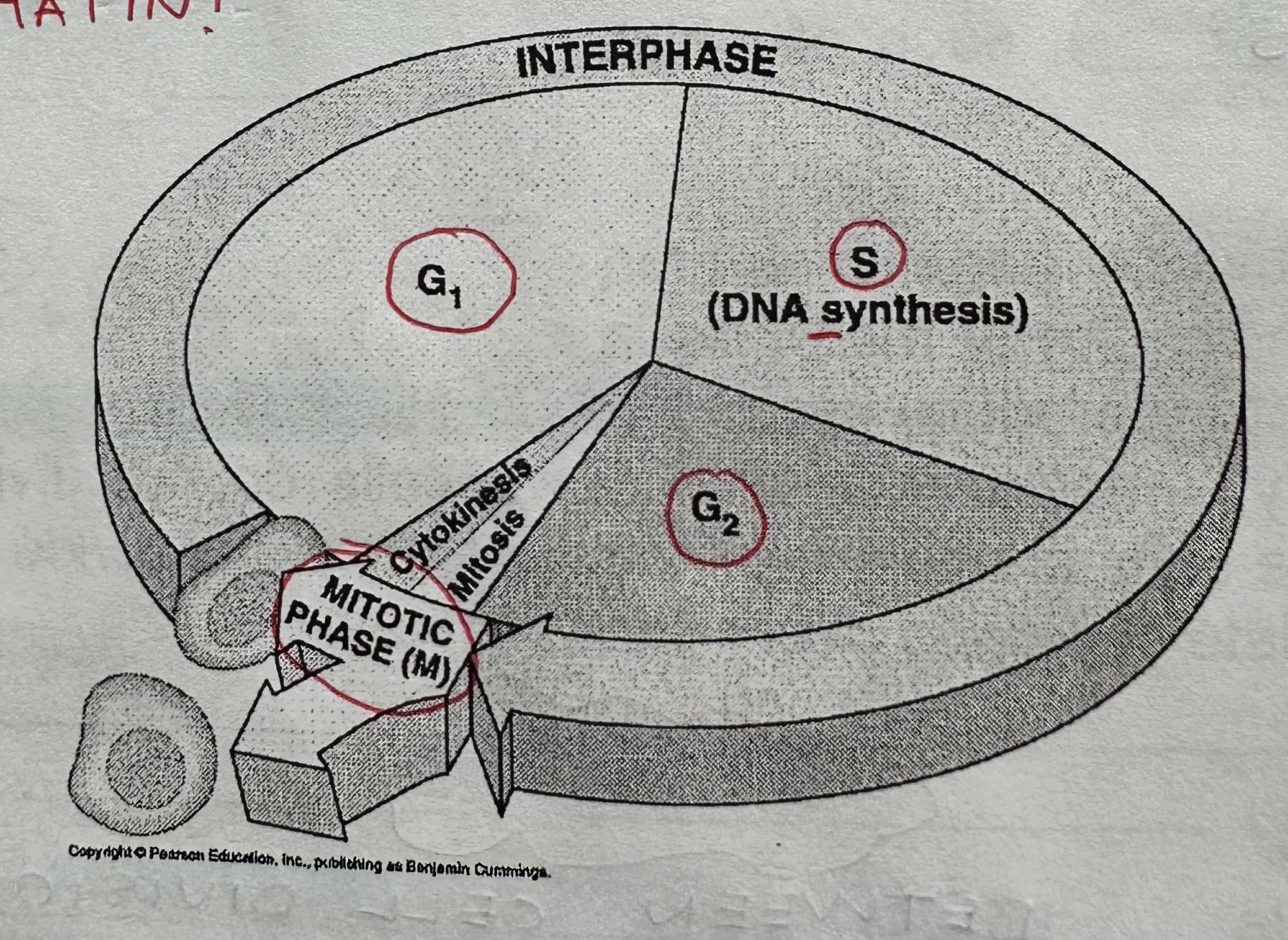
G1 Phase (Gap 1)
Follows mitosis, period of intense cellular activity and growth. Cell size and organelle numbers (mitochondria and ribosomes) double. High level of enzyme production to meet increased chemical activity.
Cells that remain in G1 Phase
Go into G0 (G ZERO) eg. nerve cells.
S Phase
DNA replication takes place.
G2 Phase
Structure required for mitosis are made eg. a pair of centrioles replicate into two pairs of centrioles. Second period of growth, many metabolic events occur to prepare for mitosis. DNA & histone proteins are still CHROMATIN!
Key signatures of Interphase
Nucleolus and nuclear membrane are visible, DNA & histone proteins are CHROMATIN.
As mitosis begins …
chromatin slowly coils, supercoils and condenses into short, visible, thick rods of CHROMOSOMES.
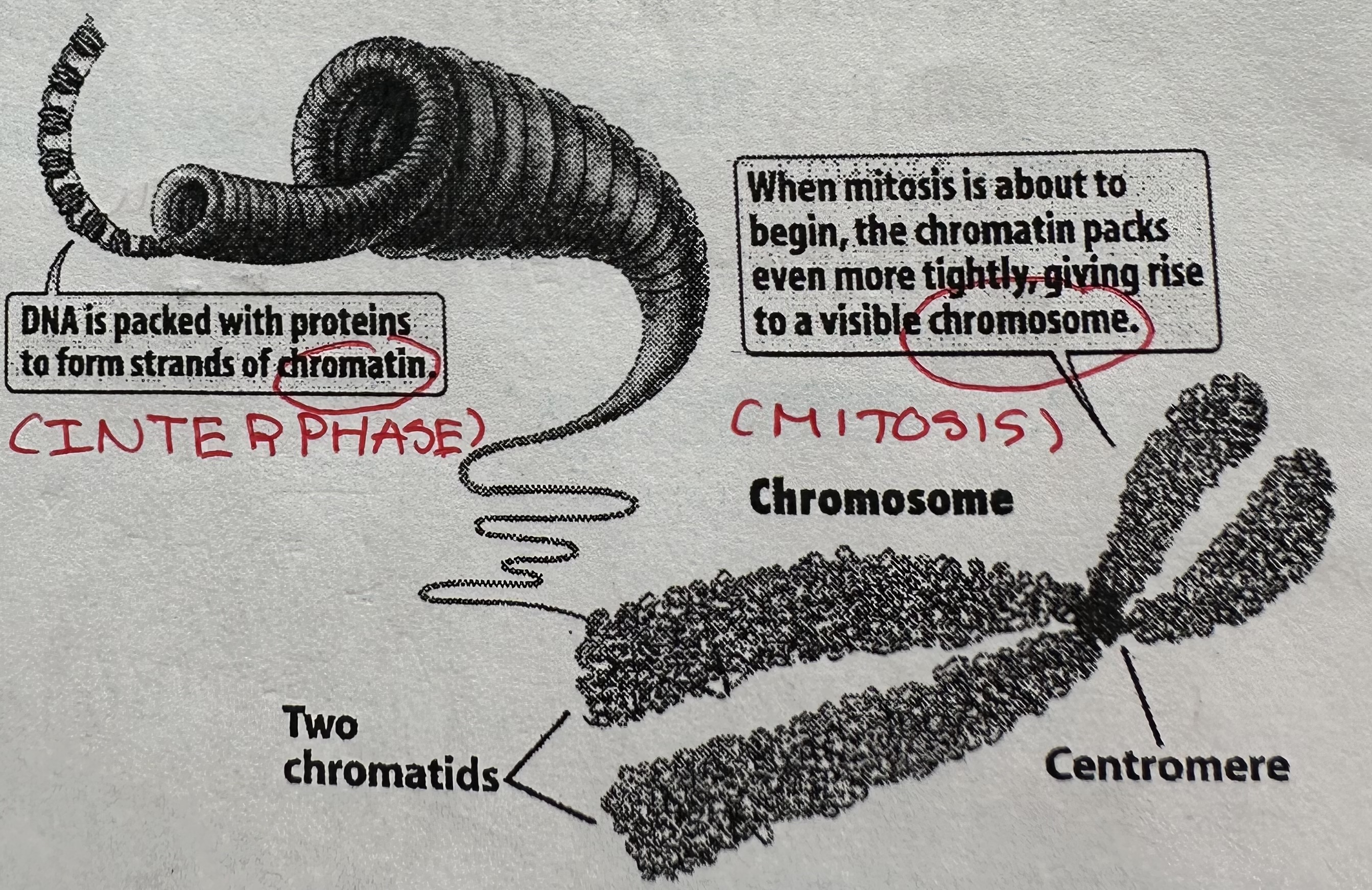
Mitosis four sequential stages
Prophase → Metaphase → Anaphase → Telophase
Prophase
1st stage
Longest phase (60% of mitosis)
Divide into early, middle and late stages.
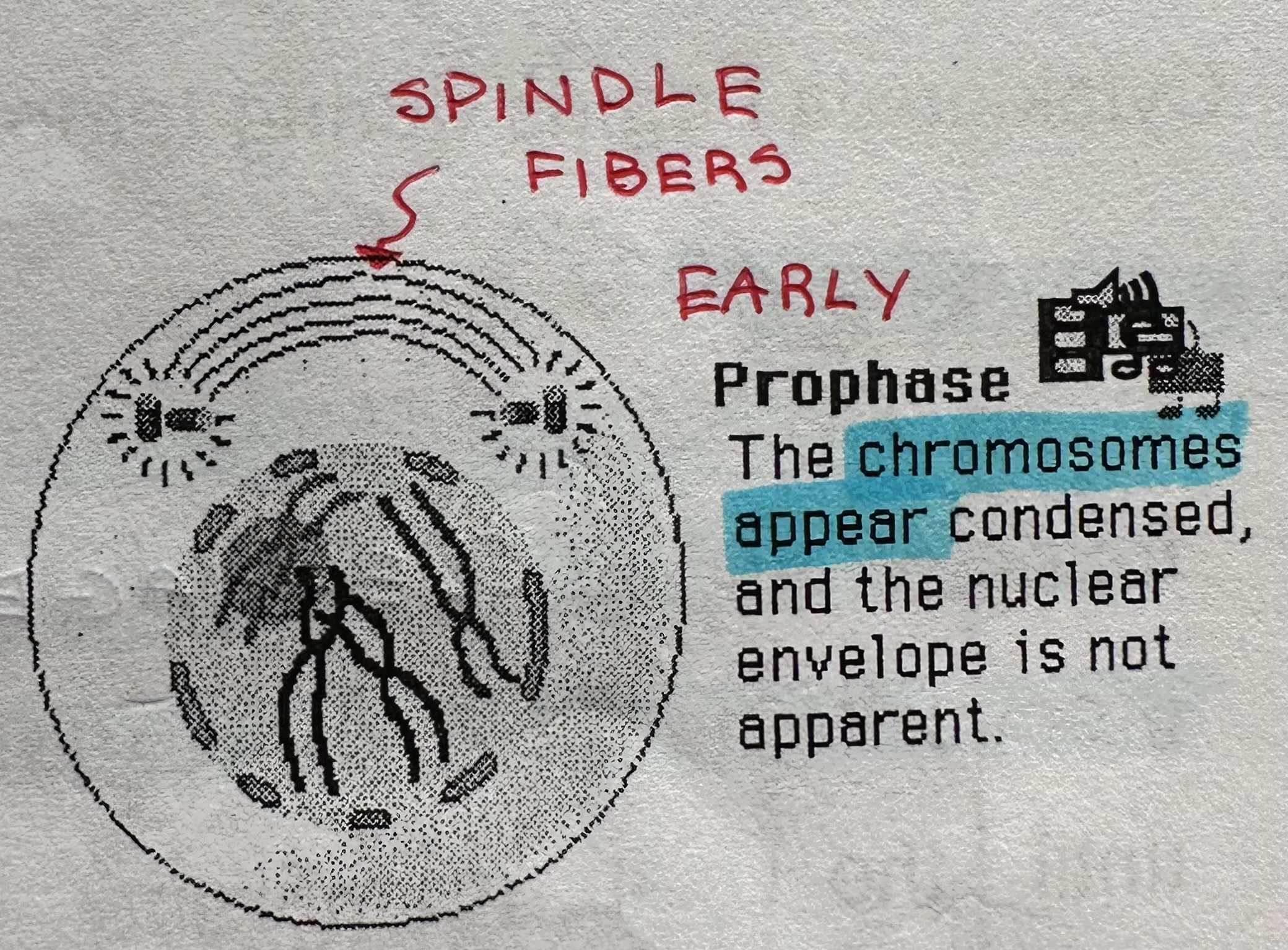
Early Prophase
CHROMOSOMES appear, NUCLEOLI breakdown and begin to dissappear, two pairs of CENTRIOLES on one side of the nucleus.
Middle Prophase
Pairs of centrioles move apart, SPINDLE FIBERS (protein microtubules) form btwn the pairs of centrioles. NUCLEAR MEMBRANE has broken down and disappeared.
Late Prophase
Pairs of centrioles are at opposite ends of the cell (poles). Chromosomes are attached to pairs of centrioles by some of the spindle fibers, other spindle fibers stretch across the cell from one centriole to the other.
Metaphase
2nd stage of mitosis
Chromosomes are pushed and pulled by spindle fibers to become arranged along the cell’s metaphase plate. CENTROMERE of each SISTER CHROMATID is attached to a SEPERATE spindle fiber.
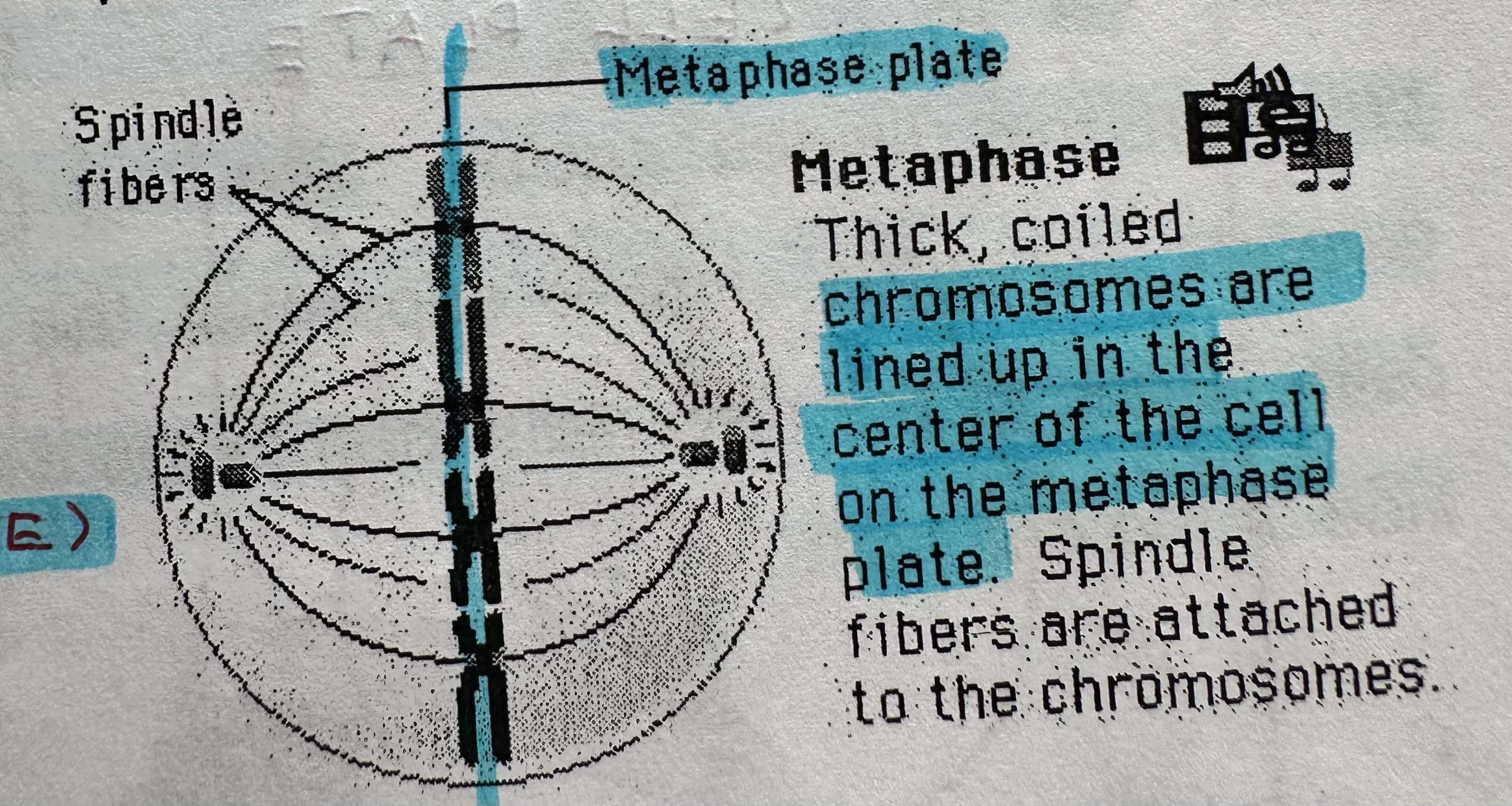
Anaphase
3rd stage of mitosis
Shortest phase (few minutes)
begins w/ seperation of CENTROMERES then seperation of SISTER CHROMATIDS.
By spindle fibers shortening, pulling the chromatids apart at the centromere.
Cell lengthens as other spindle fibers lengthen.
Ends when chromosomes stops.
Results in complete set of chromosomes at opposite ends of the cell (pole).
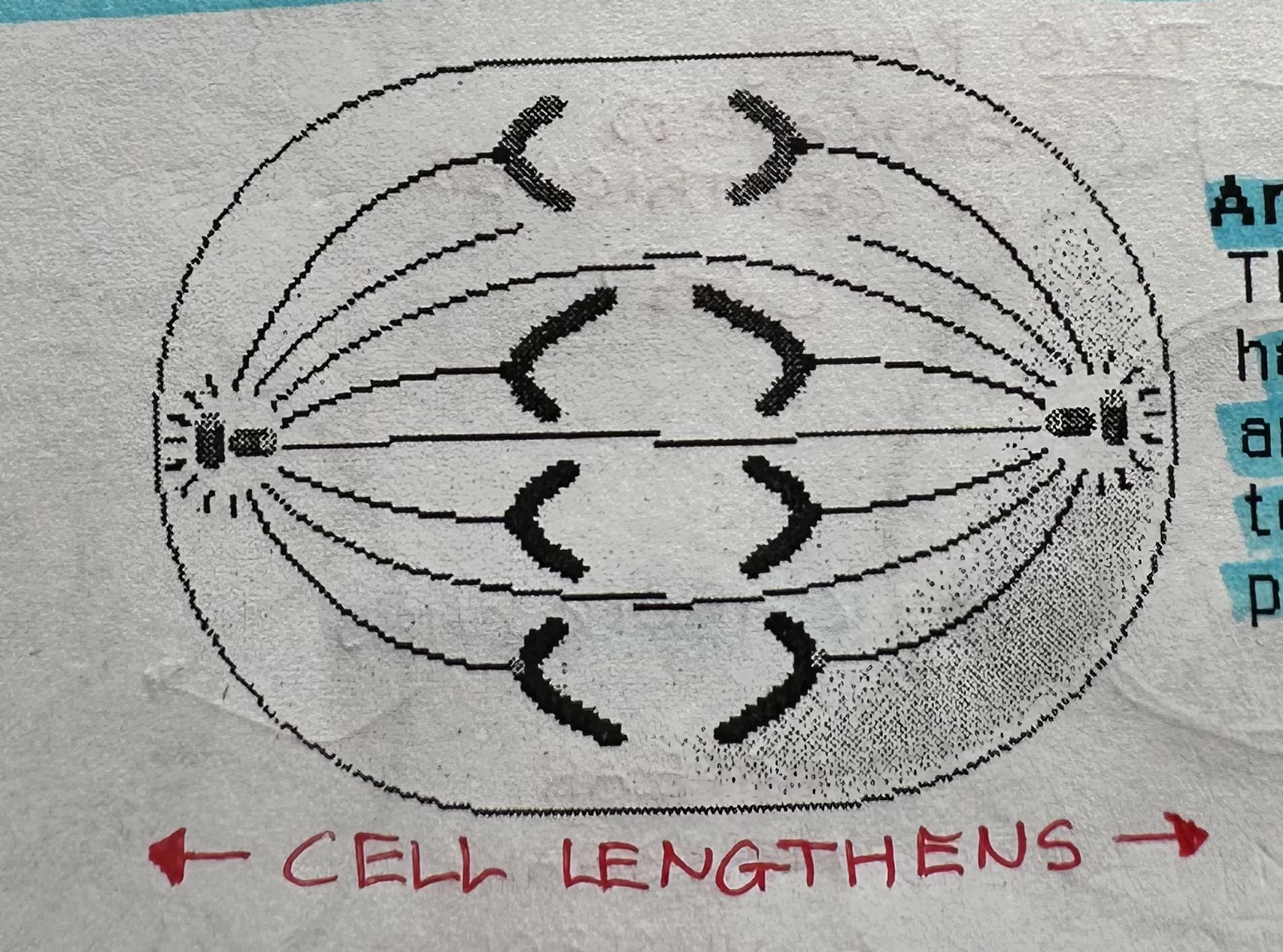
Telophase
4th and final stage of mitosis
Spindle fibers disappear.
A nuclear membrane reforms around each set of individual chromosomes as they start to uncoil and become CHROMATIN.
NUCLEOLI reform in each daughter cell nucleus.
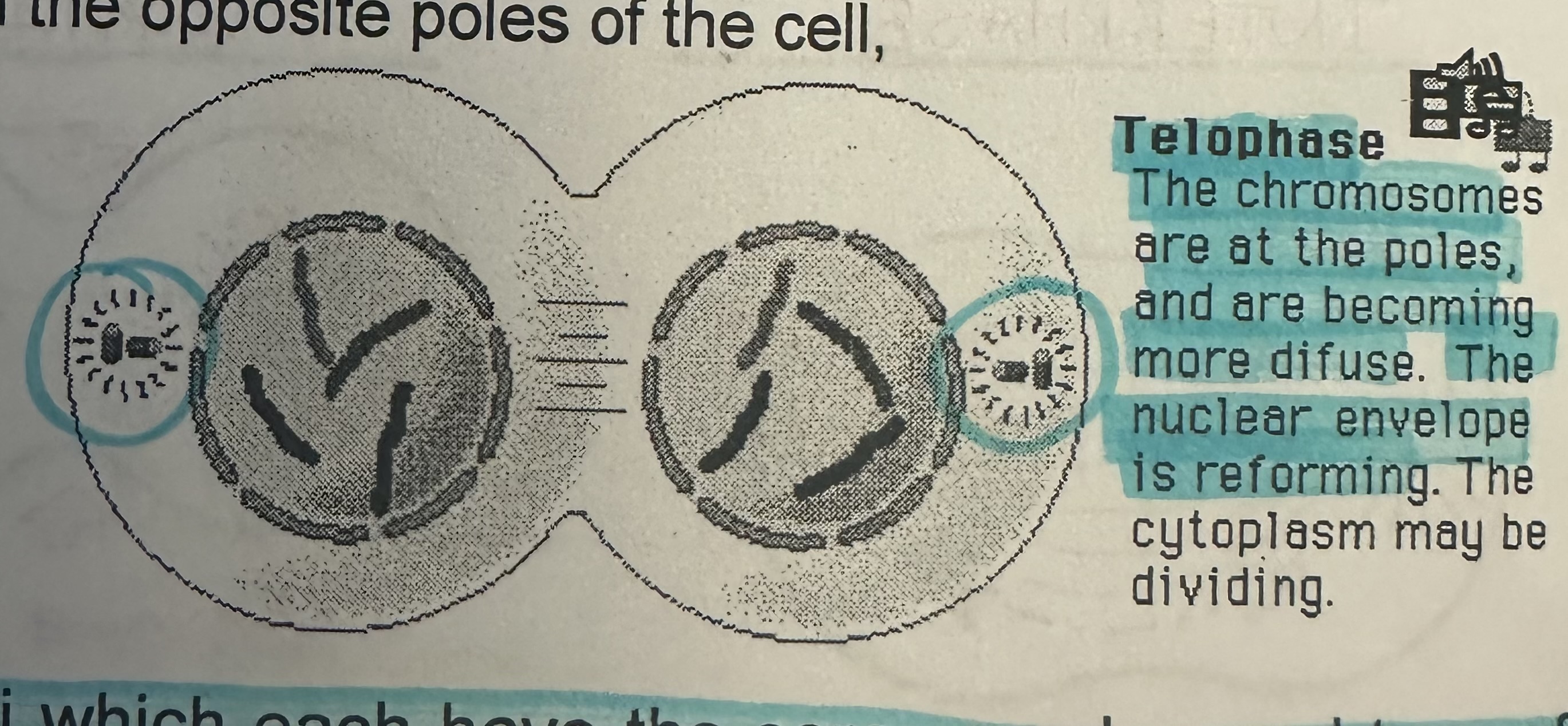
Mitosis is complete but
CELL DIVISION is not complete
Cytokinesis
Follows mitosis
A cell’s Cytoplasm divides to form two distinct daughter cells.
Begins during telophase and occurs simultaneously with telophase.
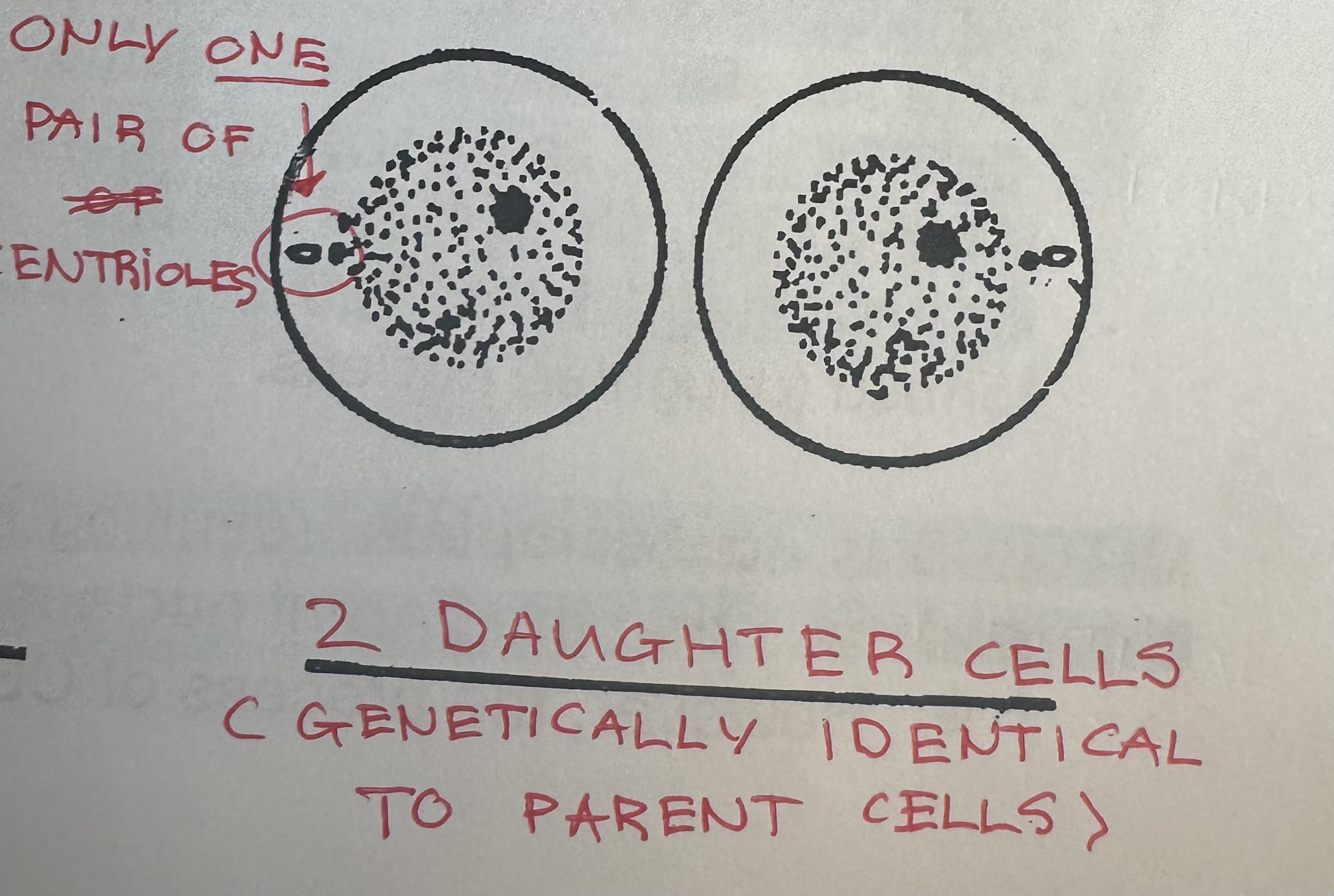
Animal cell cytokinesis
Cell membrane pinches together and a CLEAVAGE FURROW forms along the metaphase plate. It deepens until the cell membrane separates forming two daughter cells.
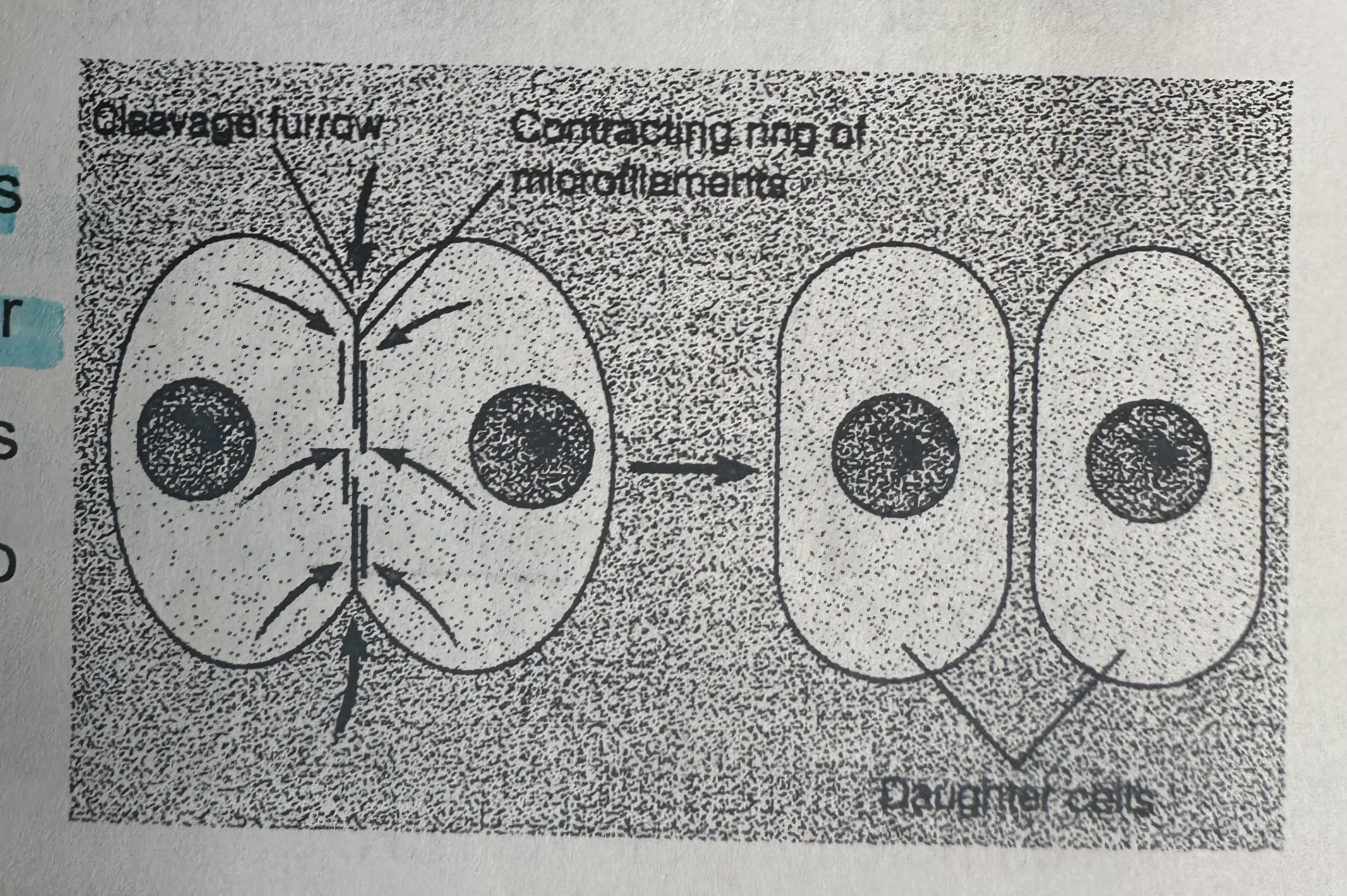
Plant cell cytokinesis
rigid cell wall prevents the cell from dividing by pinching.
So a CELL PLATE forms midway between the divided nuclei. Gradually extends outwards until it seperates the two daughter cells.
Each daughter cell then form a cell wall on its side of the cell plate.
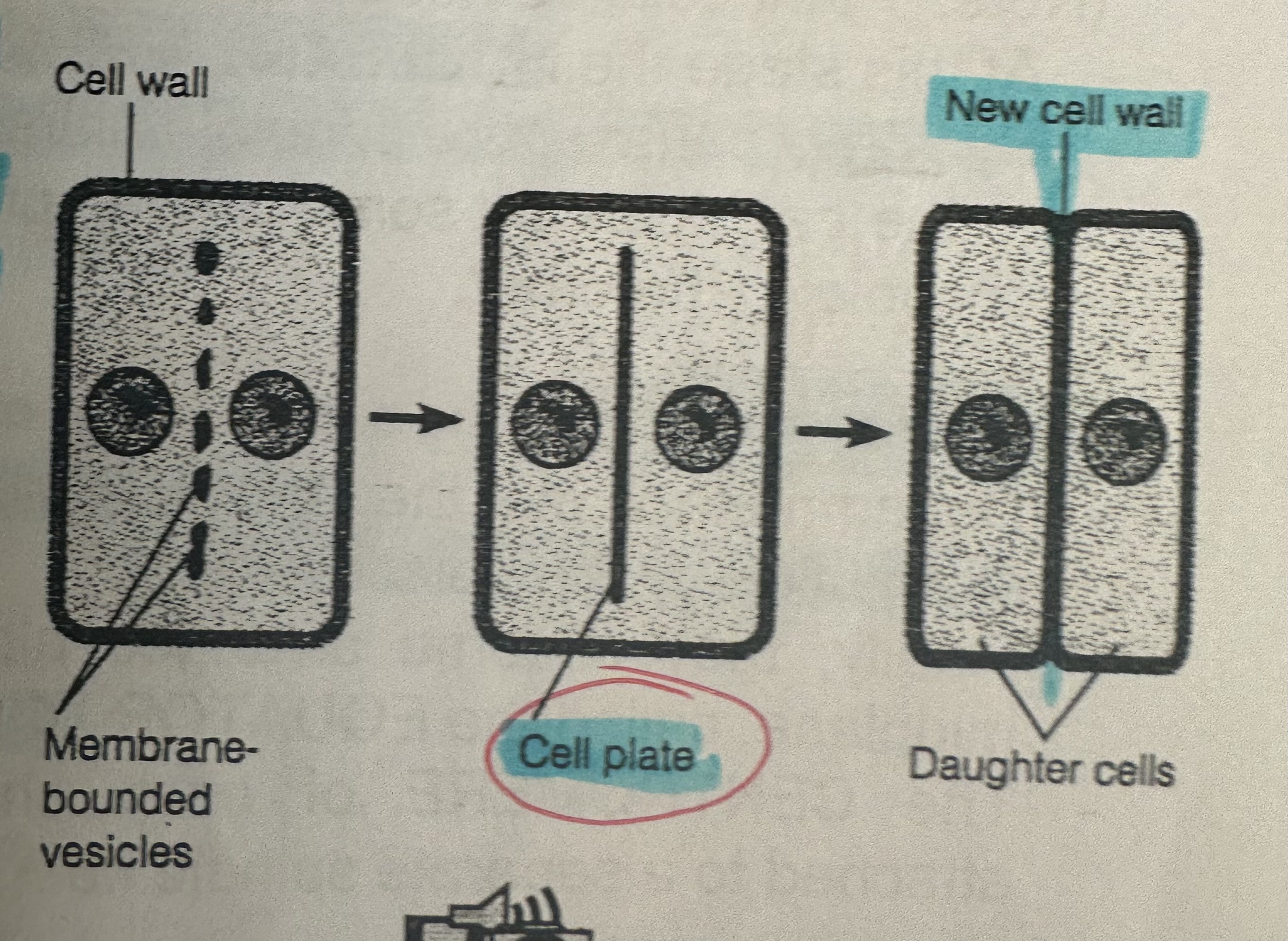
Reproduction depends on cell division
Cell division is necessary for reproduction of a single cell or of an entire multicellular organism.
Organisms reproduce in …
Two basic ways: asexual reproduction and sexual reproduction
Asexual reproduction
Production of offspring from one parent. Offspring have some of the cytoplasm and organelles of the parent cell and genetic material IDENTICAL to parent.
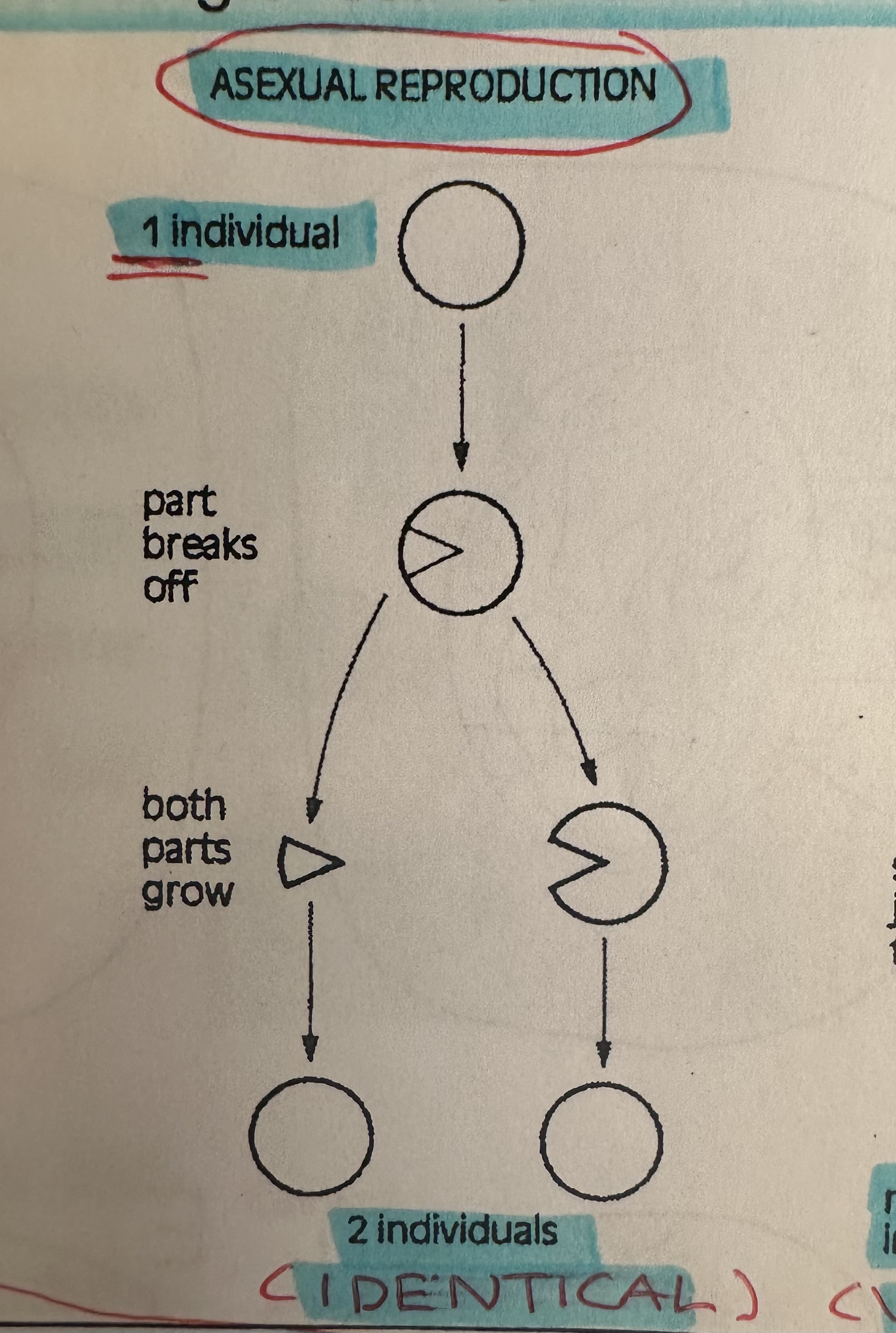
Major types of asexual reproduction ***IMPORTANT MUST KNOW***
Binary fission, budding, spore formation, fragmentation, and vegetative propagation
with all parent’s DNA is duplicated then divided equally between the offspring.
Binary fission
Simplest, organism splits into two equal-size IDENTICAL offsprings. Used by bacteria and protists.

Budding
offspring begins as a growth “bud” on the parent, when developed enough it breaks free. Reproducing organism’s divided unequally.
Used by unicellular organisms (yeast) and some multicellular organisms (plants and animals)
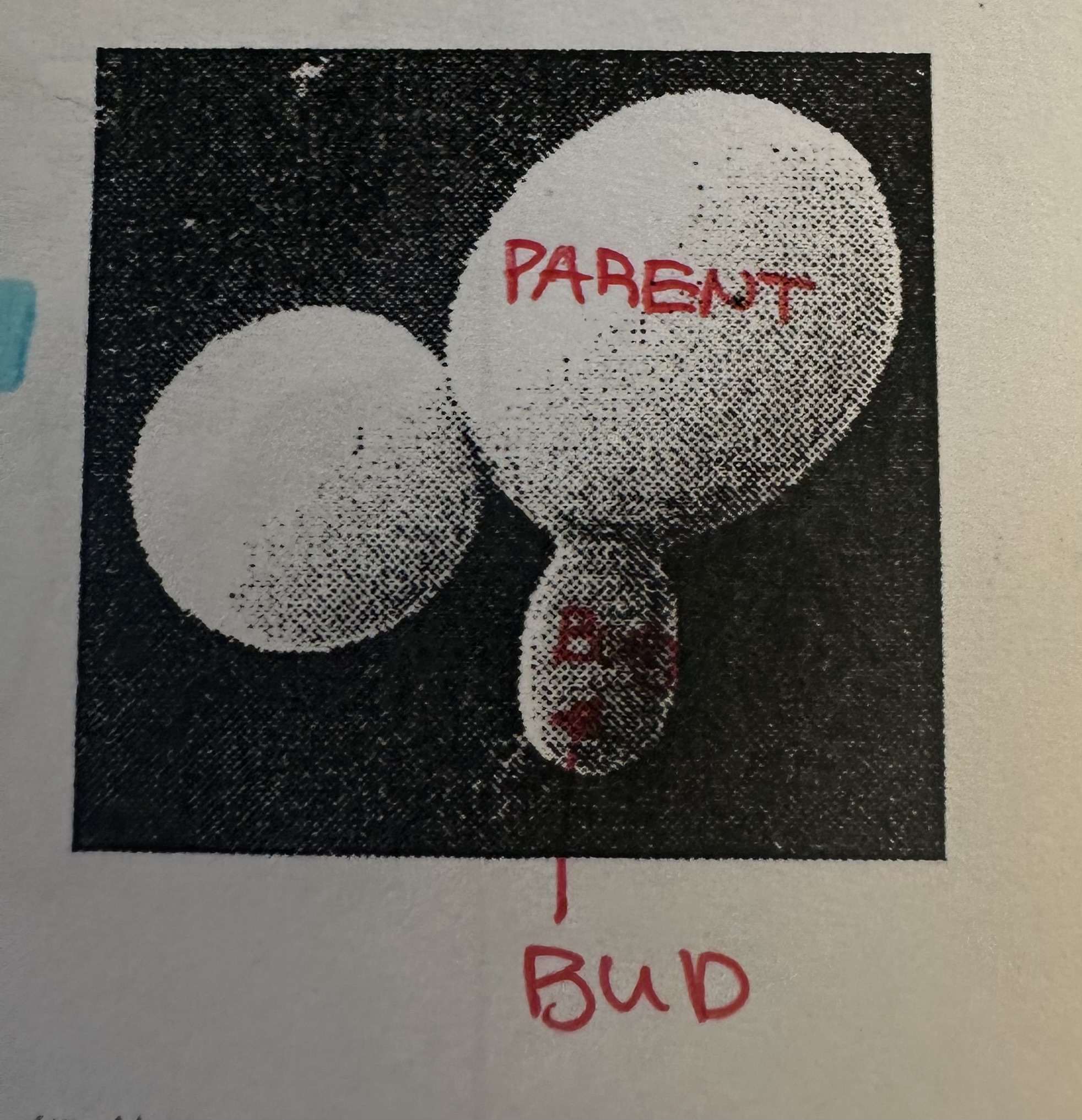
Spore formation
produces cells called “spores” that contain a nucleus and small amount cytoplasm. Lands on favourable environment develop into a new organism. Play important role in life cycle of plants.
Used by molds and other fungi.
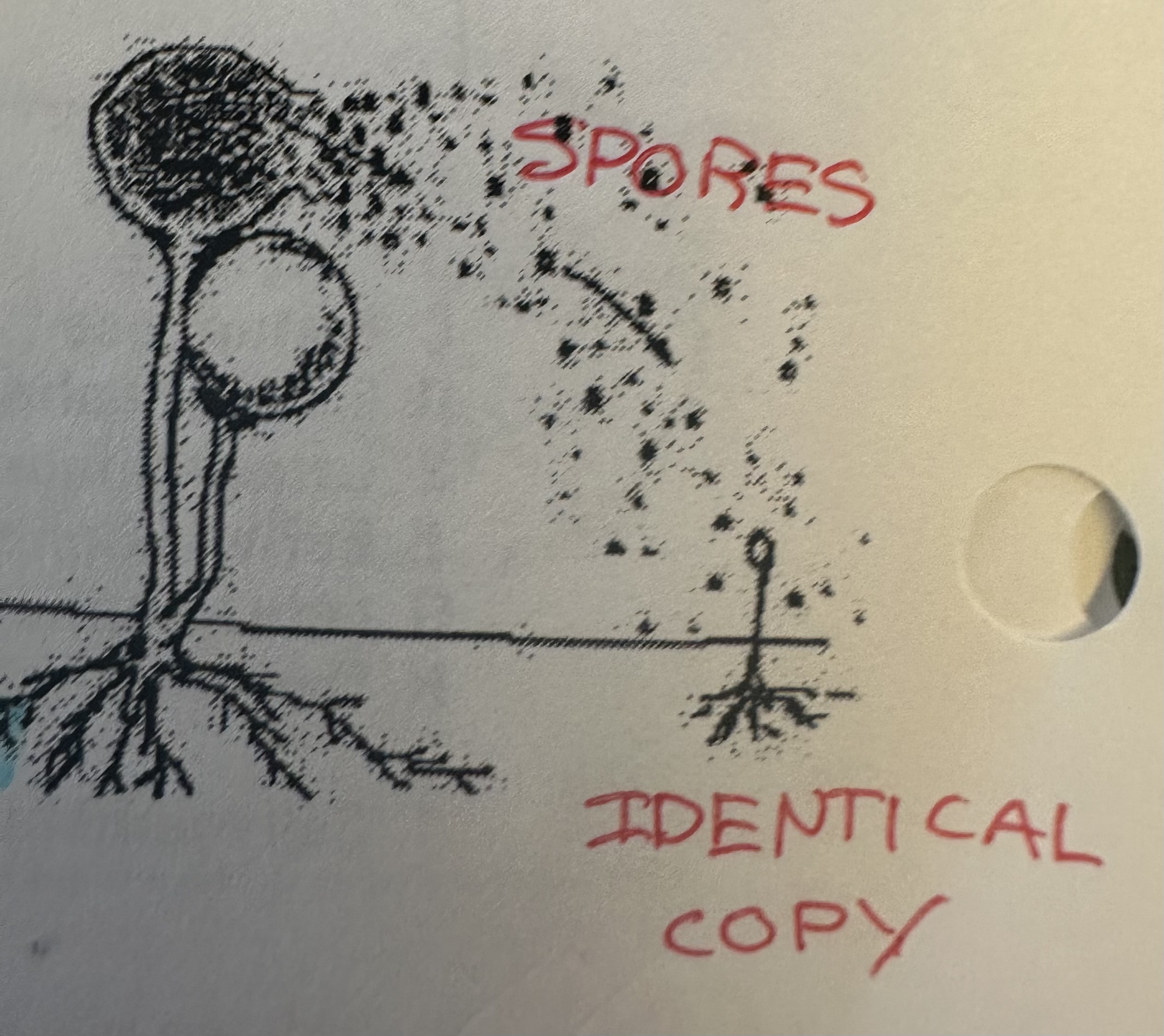
Fragmentation
fragments of parent’s break off and some grow into new whole organisms. Most do on purpose but some are by accident.
Used by starfish and flatworms (PLANARIA).
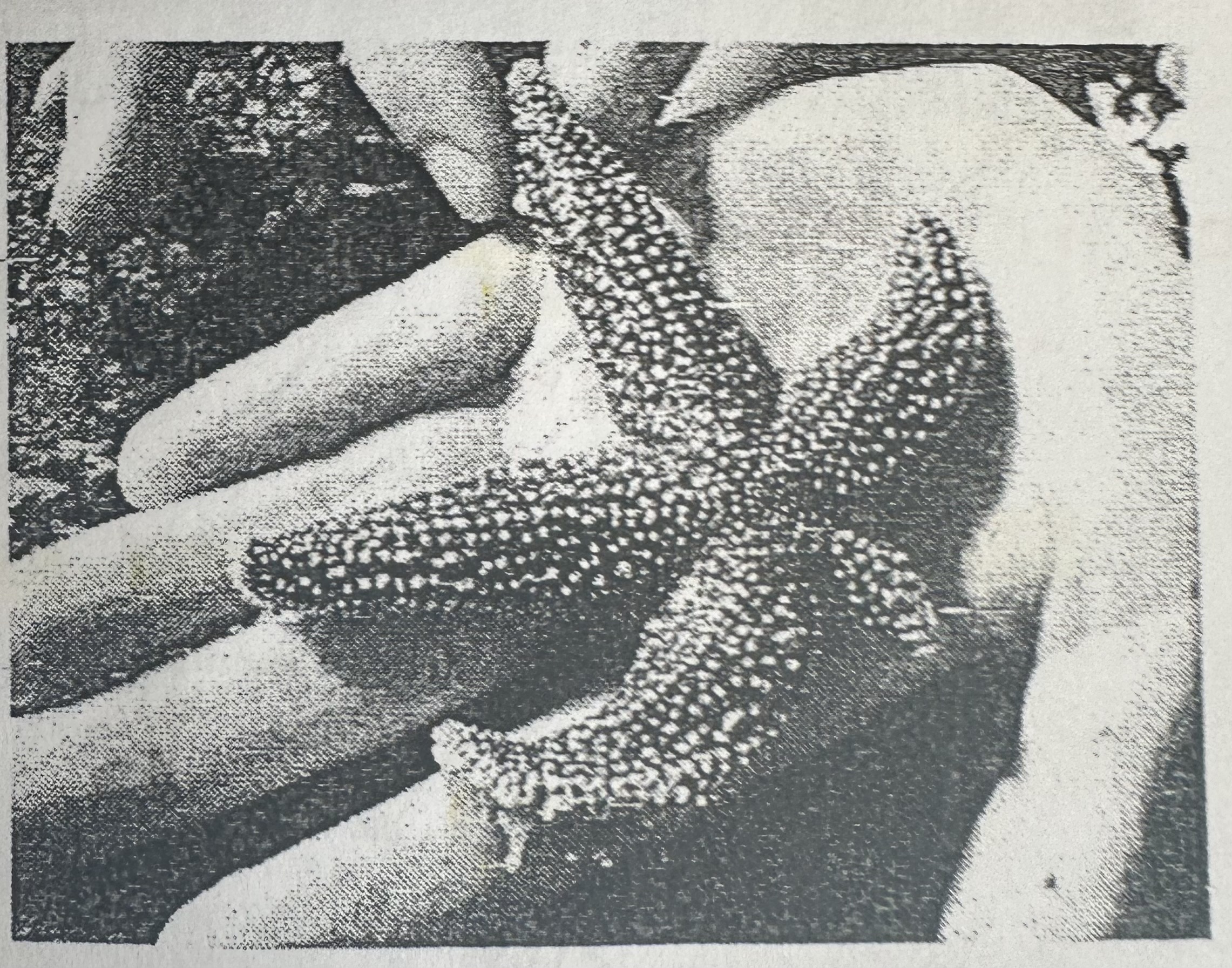
Vegetative propagation
Some plants produce organisms that are intially attached to parent plant and then seperate and become individual plants.

Example of vegetative propagation and explain 1
strawberries send out “runners” that are horizontal aboveground stems that when they contact fertile soil grow roots and develop into a new individual plant.
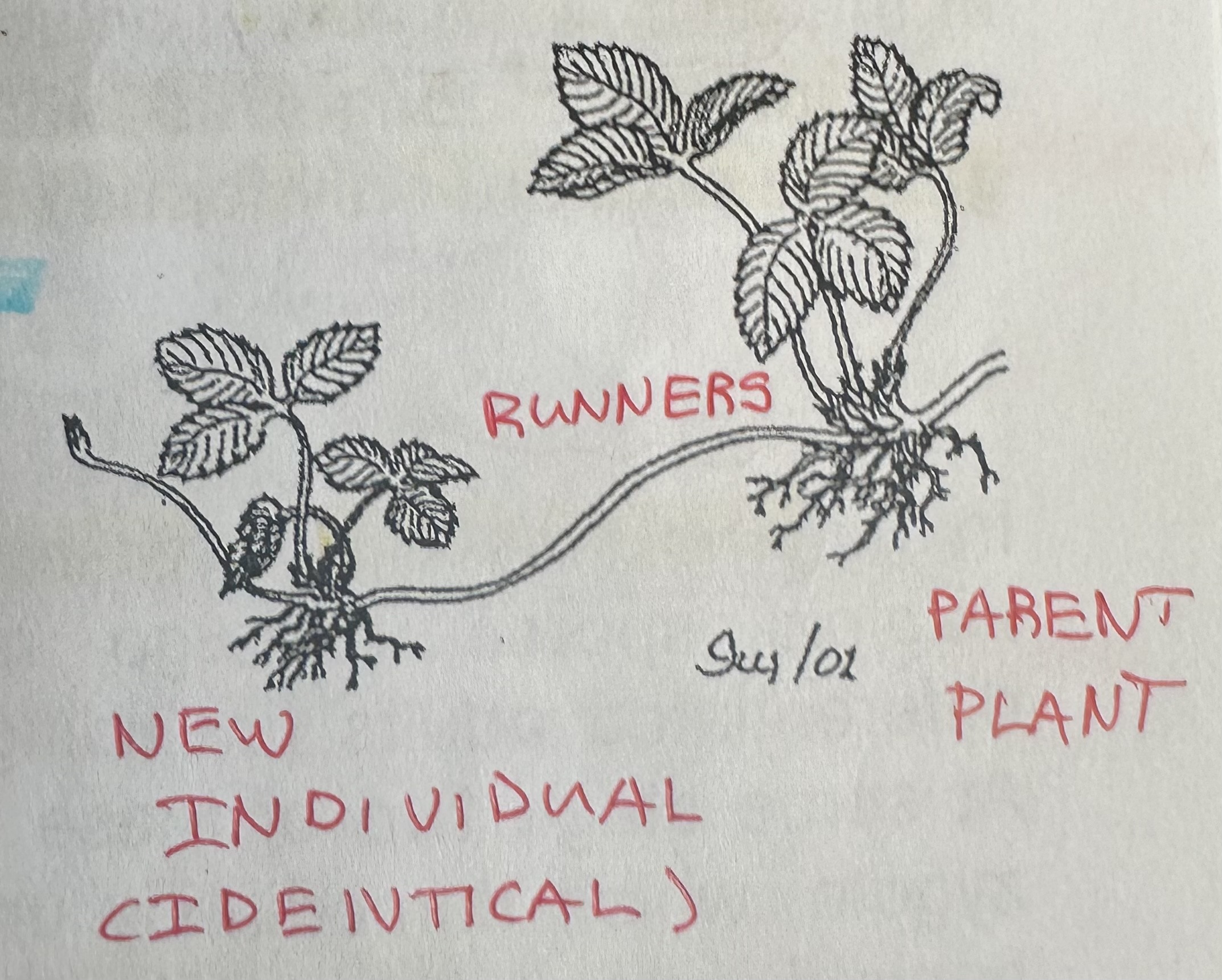
Example of vegetative propagation and explain 2
Tuber plants eg. potatoes propagate through underground runners that develop from “eyes”.
Some form tiny plants on edges of their leaves that drop and root in the soil.
Parthenogenesis ***MUST KNOW***
Unique form of reproduction
Used by some plants (citrus fruit eg. oranges) and some invertabrate animals (eg. honeybees, aphids, some crustaceans).
Alternative to sexual reproduction.
Egg cells develop into adult clones WITHOUT being FERTILIZED. They may be HAPLOID or chromatin may replicate to form diploid cells.
Sexual reproduction
Production of offspring from two parent using GAMETES. Both parents contribute same # of chromosomes to offspring. It is usually not identical to either parents but may have some characteristics of each.
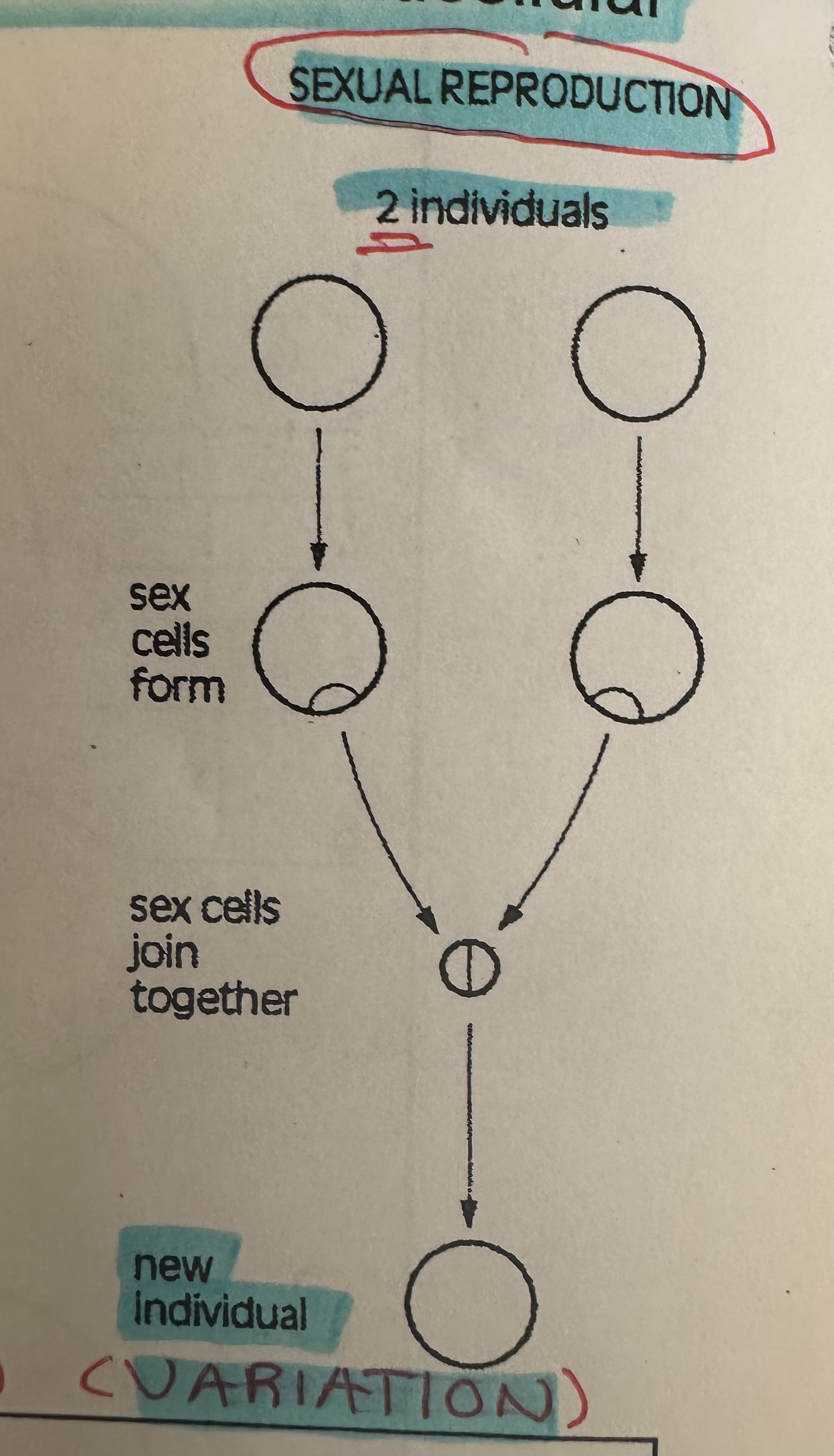
Gametes
Specialized cells that are HAPLOID (n) = only have half the number of chromosomes of parent cells.
Offspring (zygote)
DIPLOID (2n) = full or 2 sets of gamete’s chromosomes (one from each parent).
2 stages of sexual reproduction
Meiosis → syngamy (fertilization)
Meiosis
Production of GAMETES: sperm/egg have only half # of chromosomes as SOMATIC (body) cells.
Occurs in sex organs or GONADS (testes 4 male, ovaries 4 females)
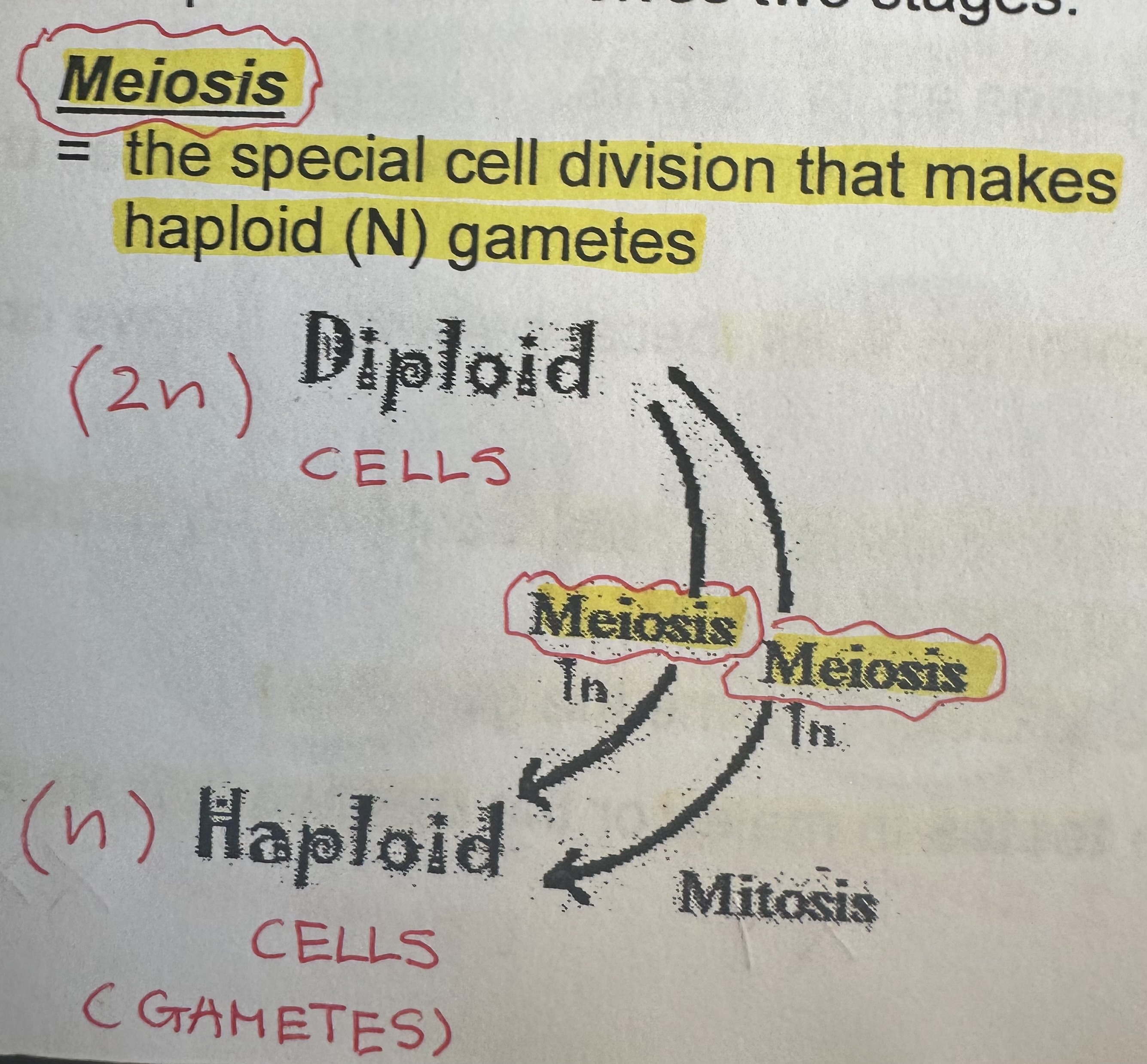
Syngamy
also known as Fertilization
The fusion of two gametes to form a diploid (2n) zygote.

Sexual life-cycle
Sexually-reproducing species alternate between diploid (2n) and haploid (n) forms. Use mitosis to grow into adult organisms.
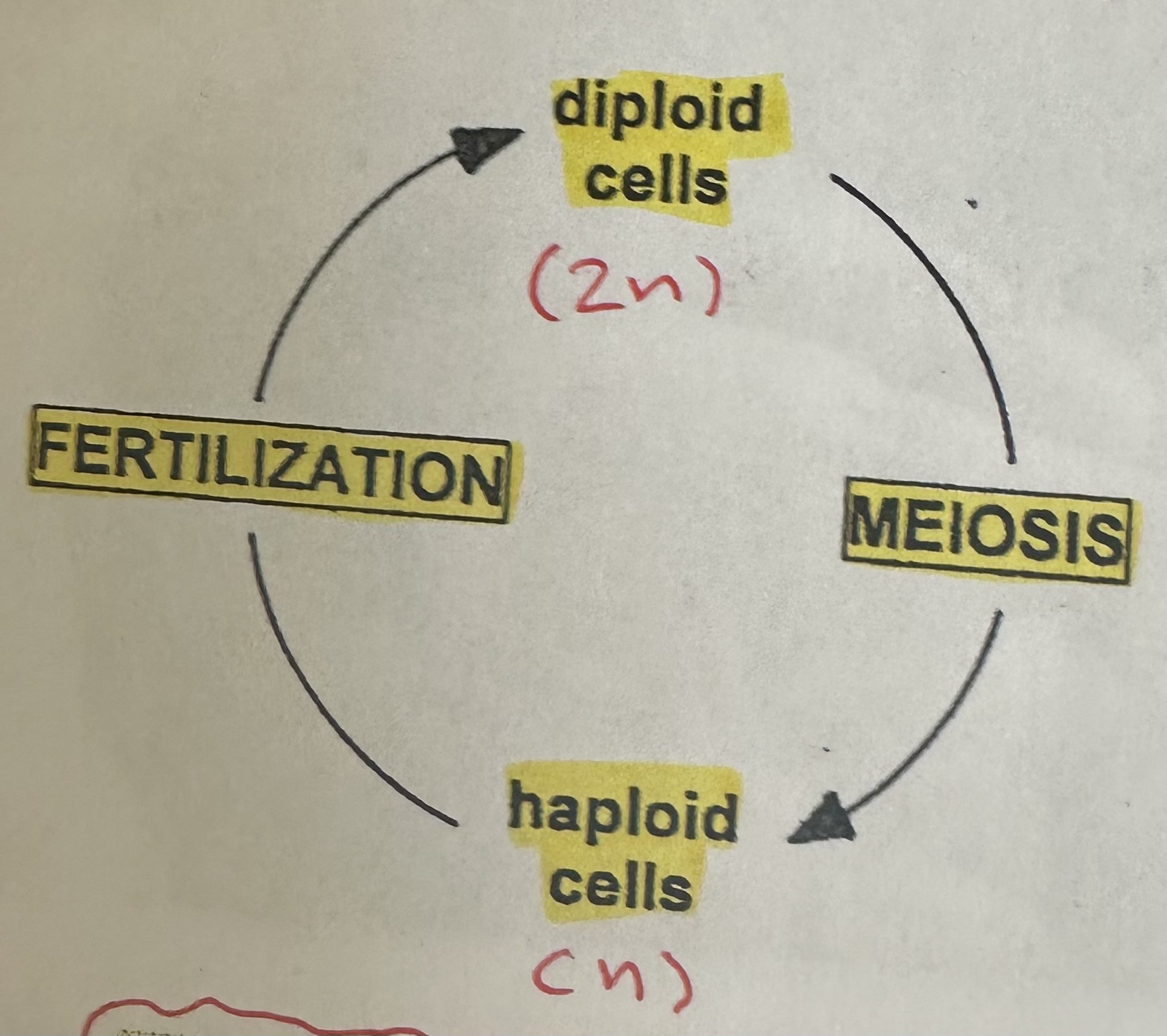
ANIMALIA sexual life-cycle
Dominant long-lived adult form is diploid and haploid gamete cells are only formed briefly.
Flowering plants have this too.
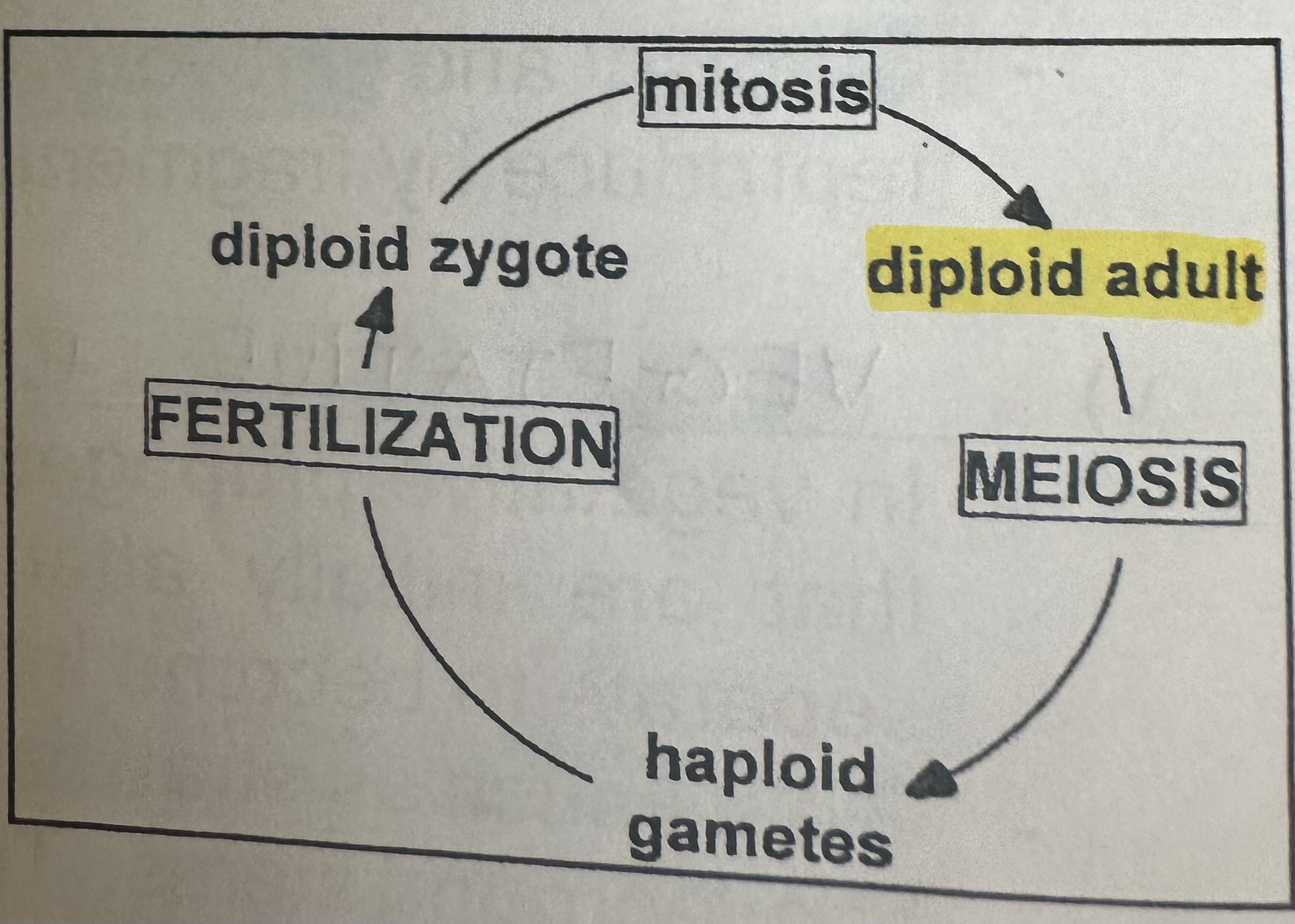
FUNGI sexual life-cycle
Dominant long-lived adult form is haploid. Haploid spores do mitosis and grow into complete differentiated adults (mushrooms). Two haploid cells fuse into diploid zygote and meiosis back to haploid and complete cycle.
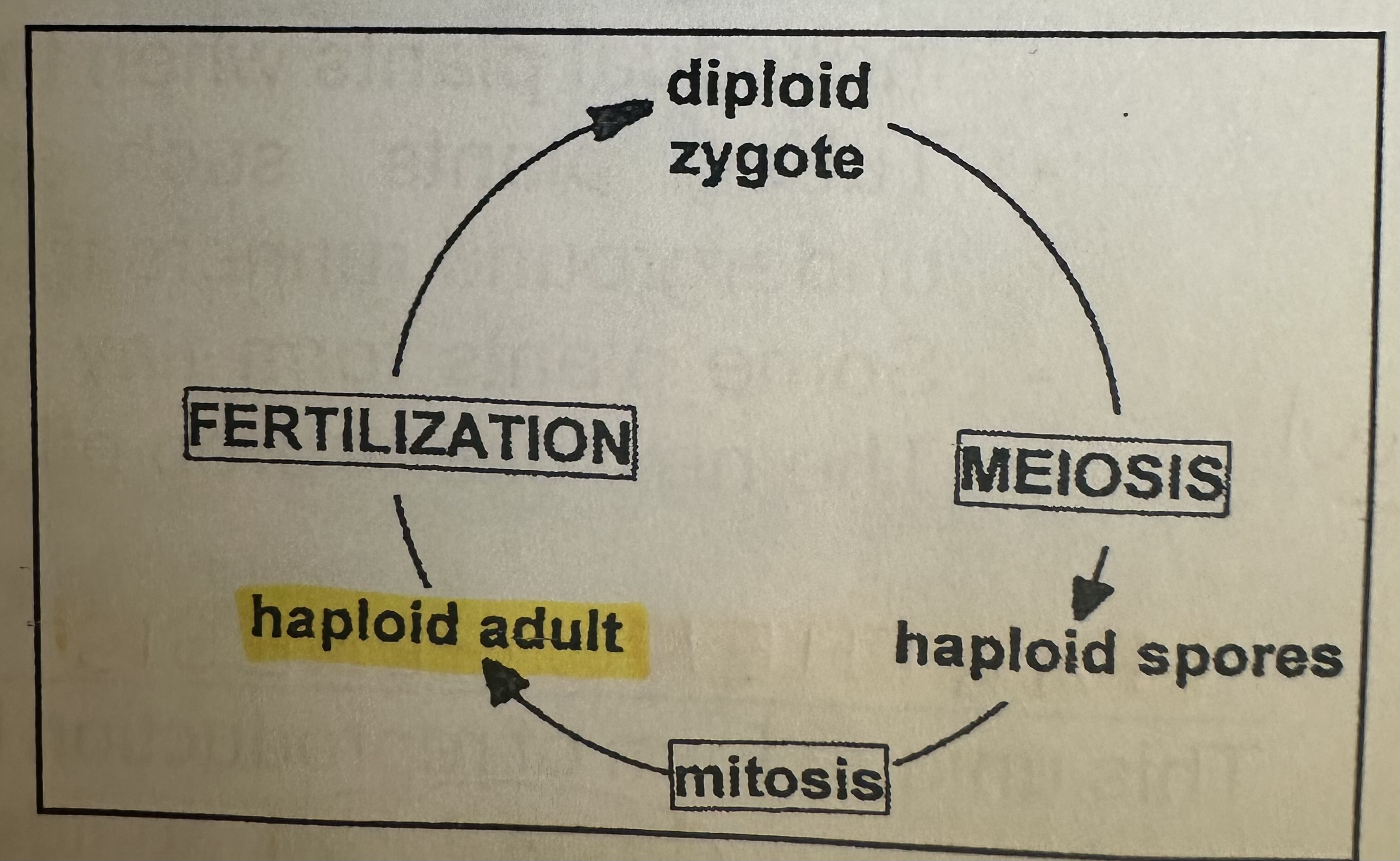
PLANTAE sexual life-cycle
shows ALTERNATION OF GENERATIONS. Have two distinct adult forms one diploid and other haploid.
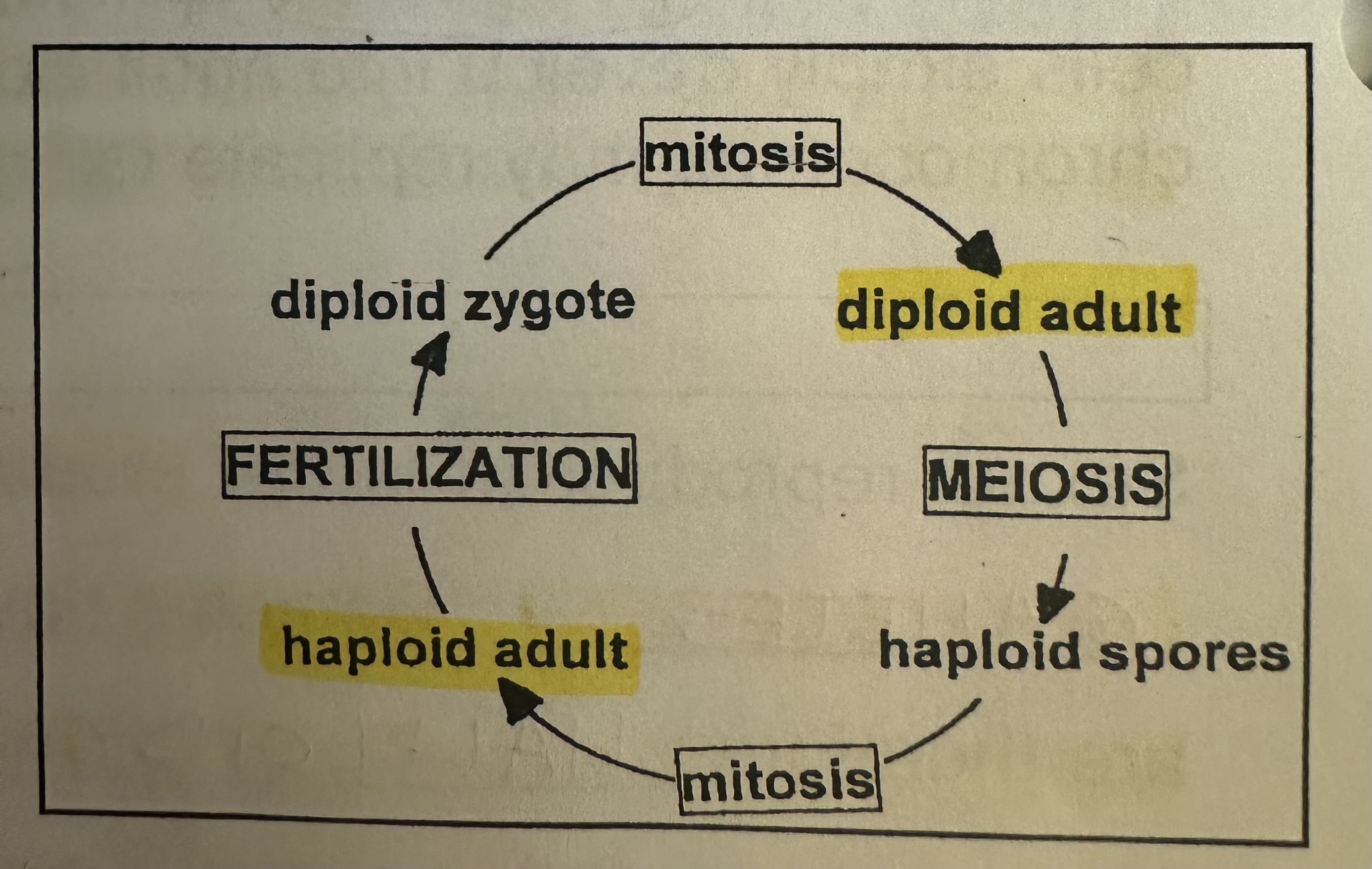
Phases of meiosis
Process that haploid (n) daughter cells are formed from a diploid (2n) parent cell.
Requires TWO successive cell divisions.
Starts with DNA replication (like mitosis) then two divisions one immediately after the other.
Results in FOUR daughter cells unlike mitosis is two.
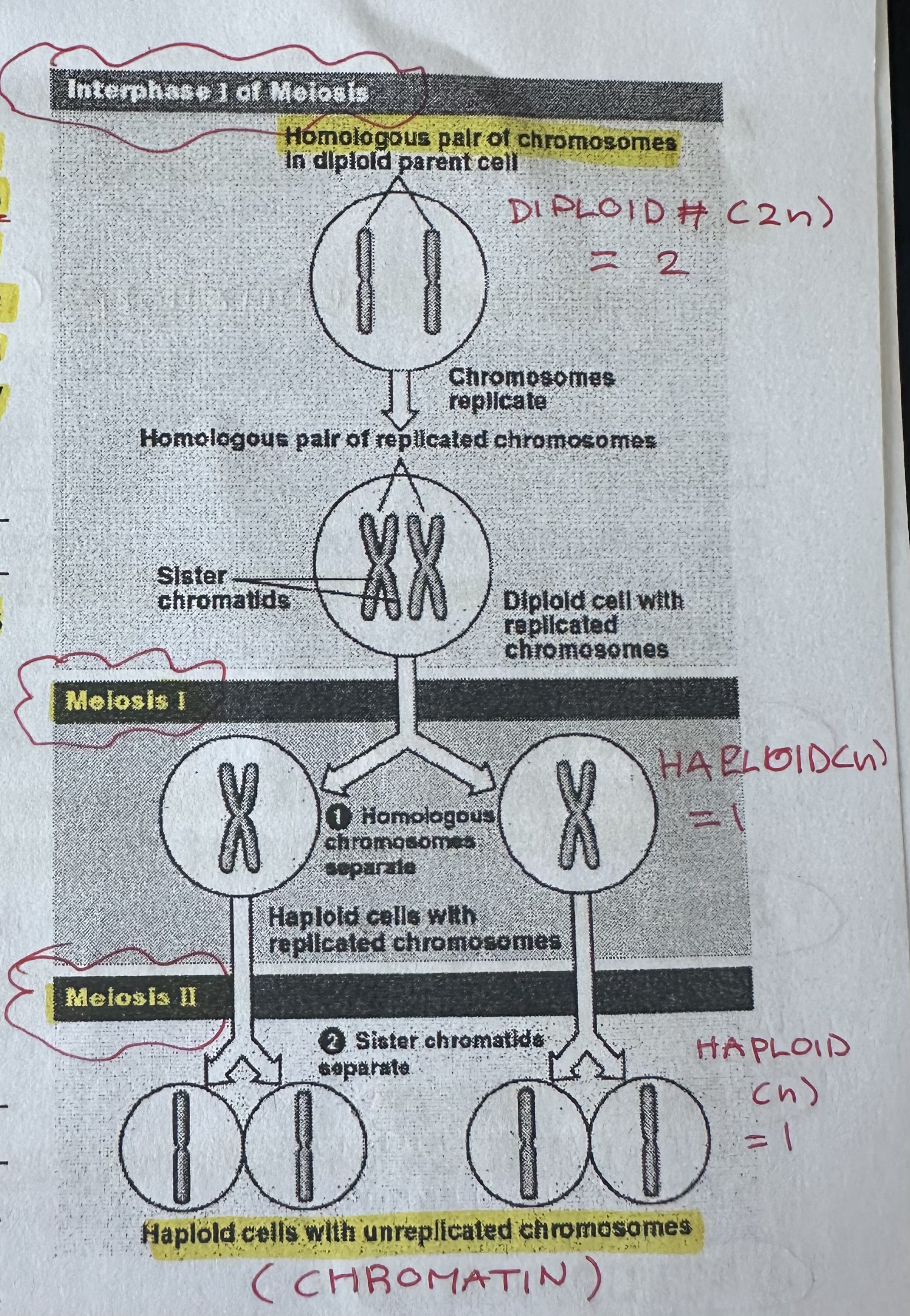
Premeiotic interphase
Prior to meiosis, all DNA replicated similar to S phase of interphase prior to mitosis.
Chromatin, nuclear membrane, nucleolus present.
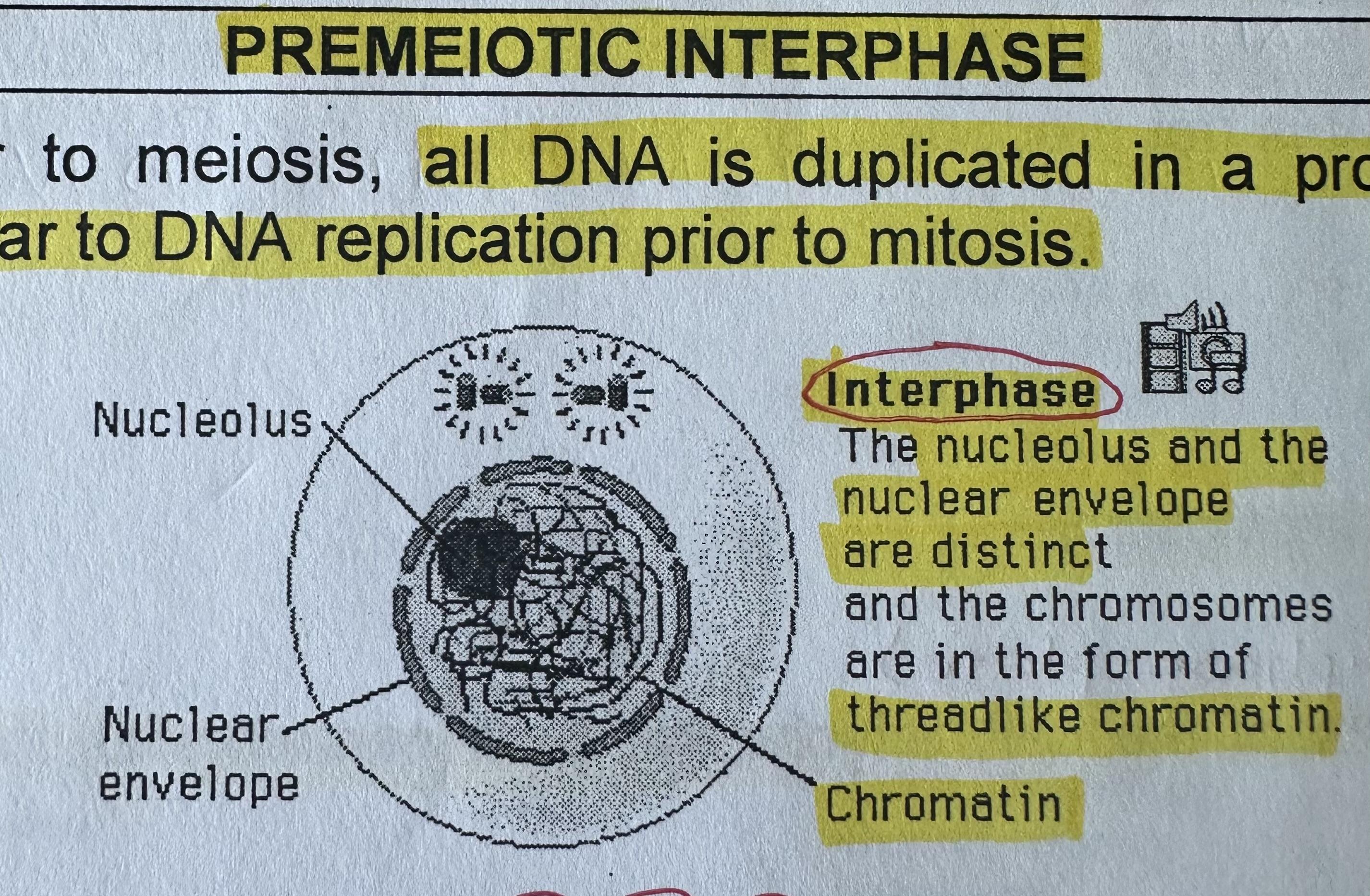
Meiosis I
Reduction; reduces the # of chromosomes from diploid # (2n) to haploid # (n)
Meiosis I phases
Prophase I, Metaphase I, Anaphase I, Telophase I + Cytokinesis
Prophase I
Chromatin → chromosomes
Spindle fibers appear
Nucleoli breakdown
By end:
Nuclear membrane gone, synapsis occurs and tetrads visible
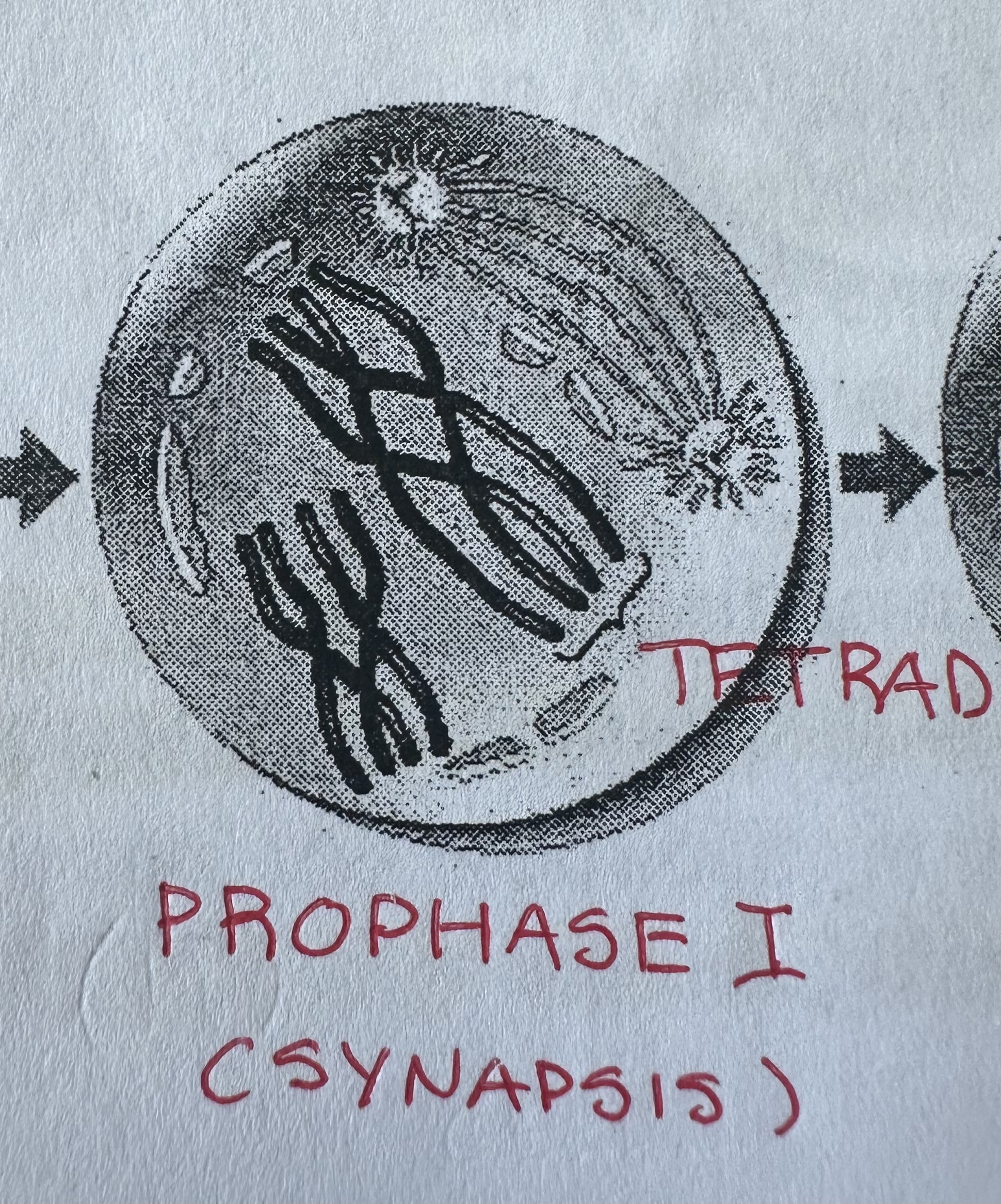
Synapsis
Homologous chromosomes coming together forming a tetrad
Tetrad
structure that is homologous chromosomes lying next to each other.
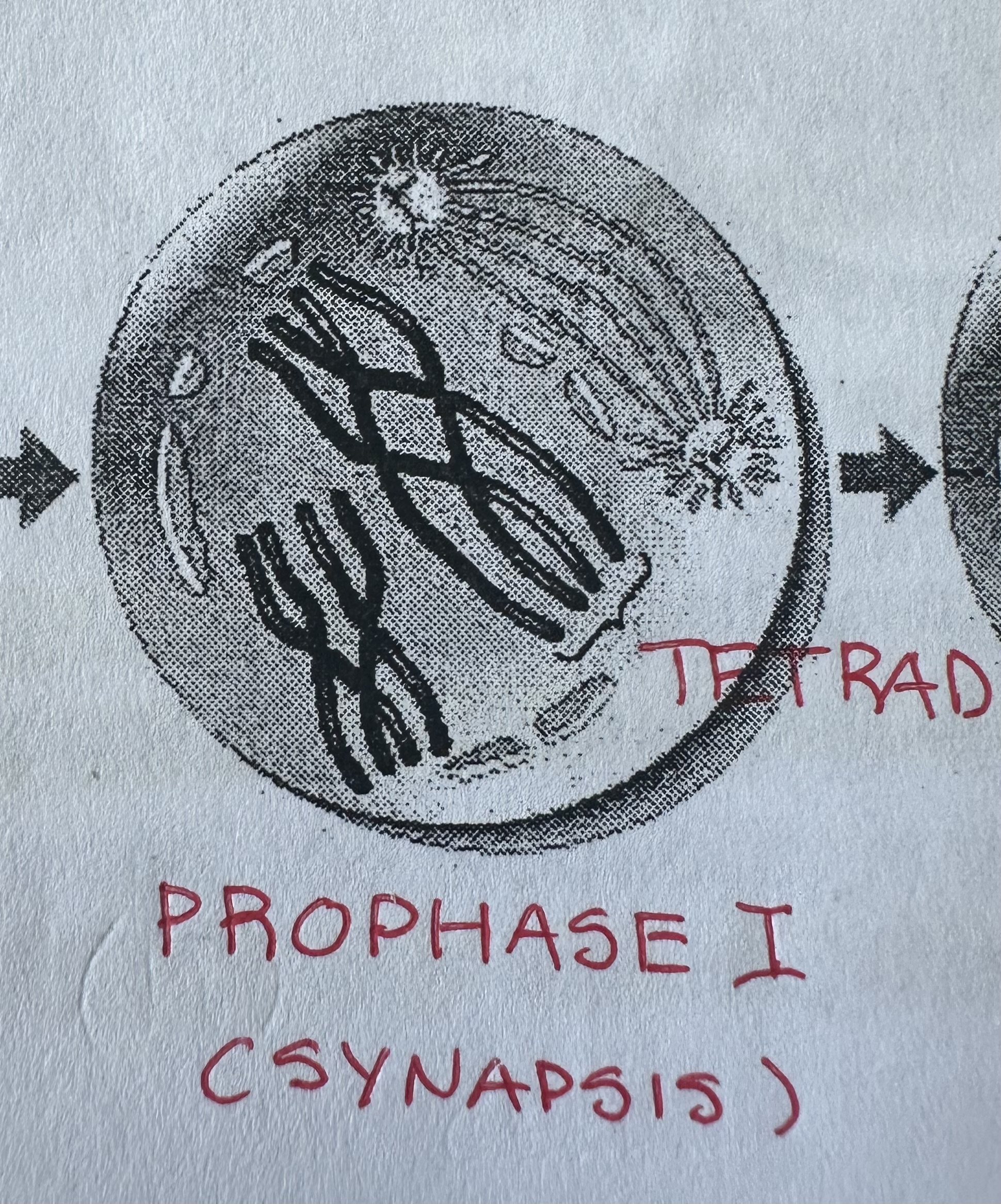
Metaphase I
Each tetrad lines up along metaphase plate
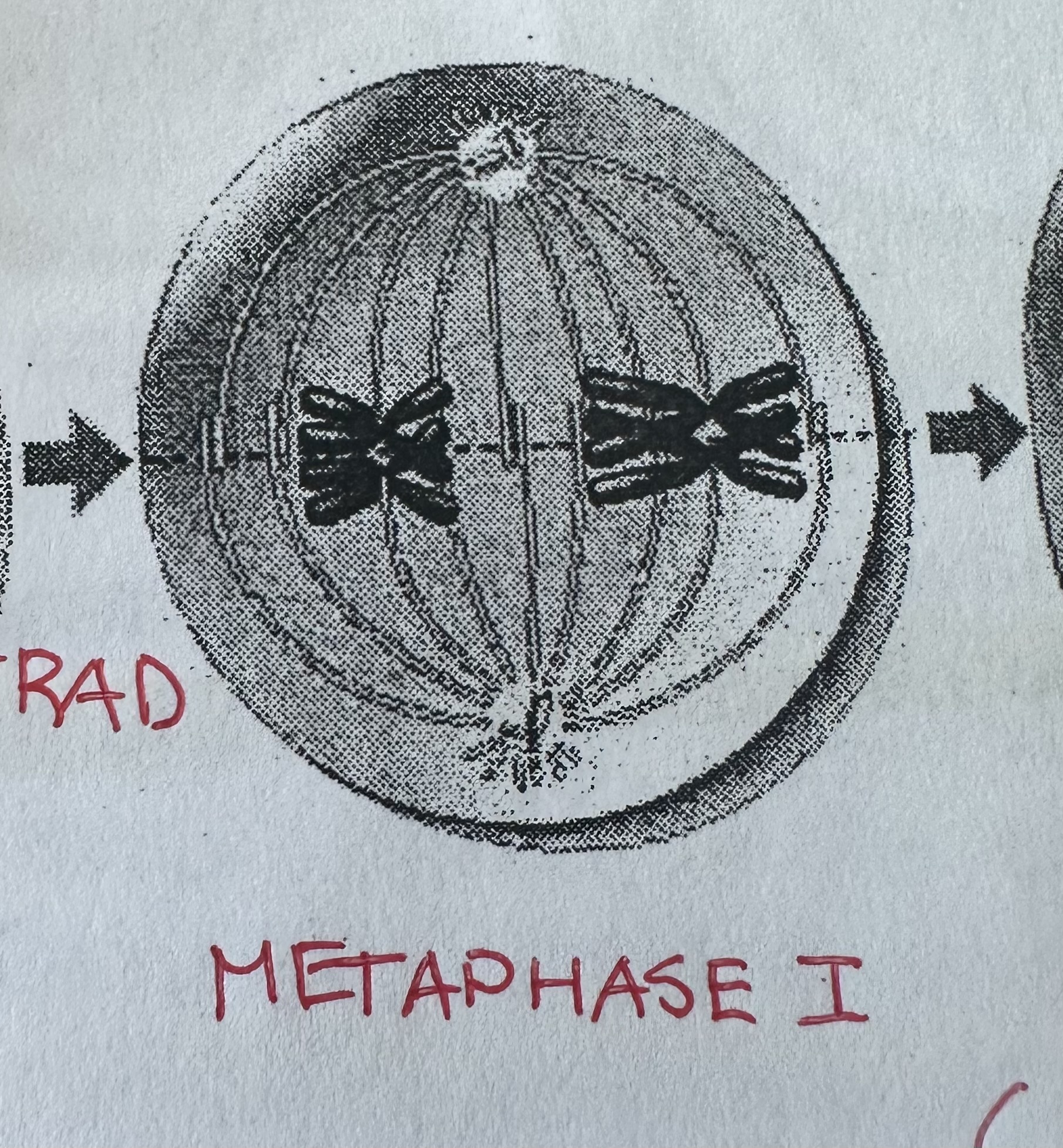
Anaphase I
Homologous chromosomes of each tetrad pulled apart, each goes to opposite ends.
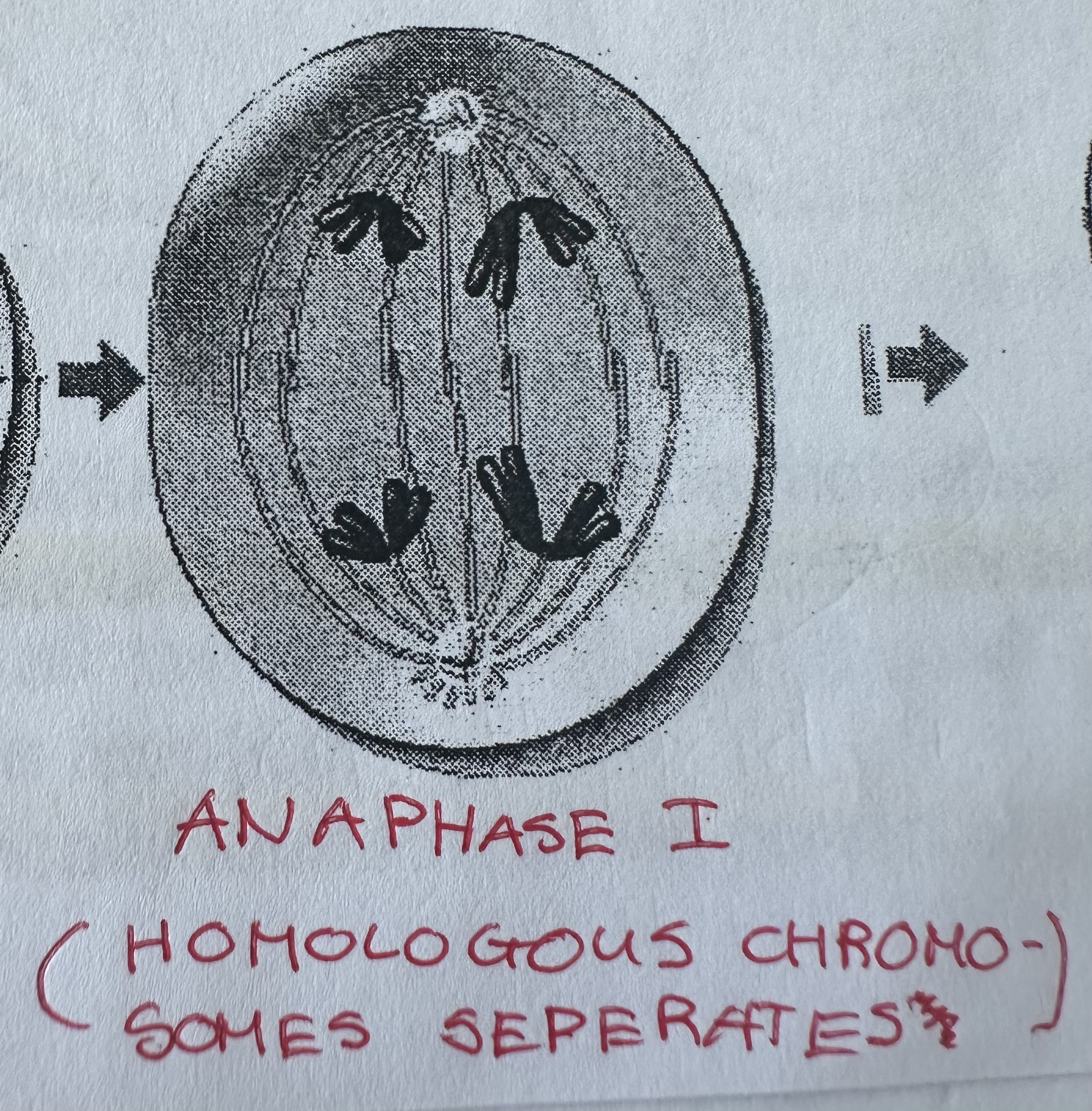
Telophase I + Cytokinesis
Seperated chromosomes reach the ends of the cell, cytokinesis splits the cell into two haploid daughter cells.
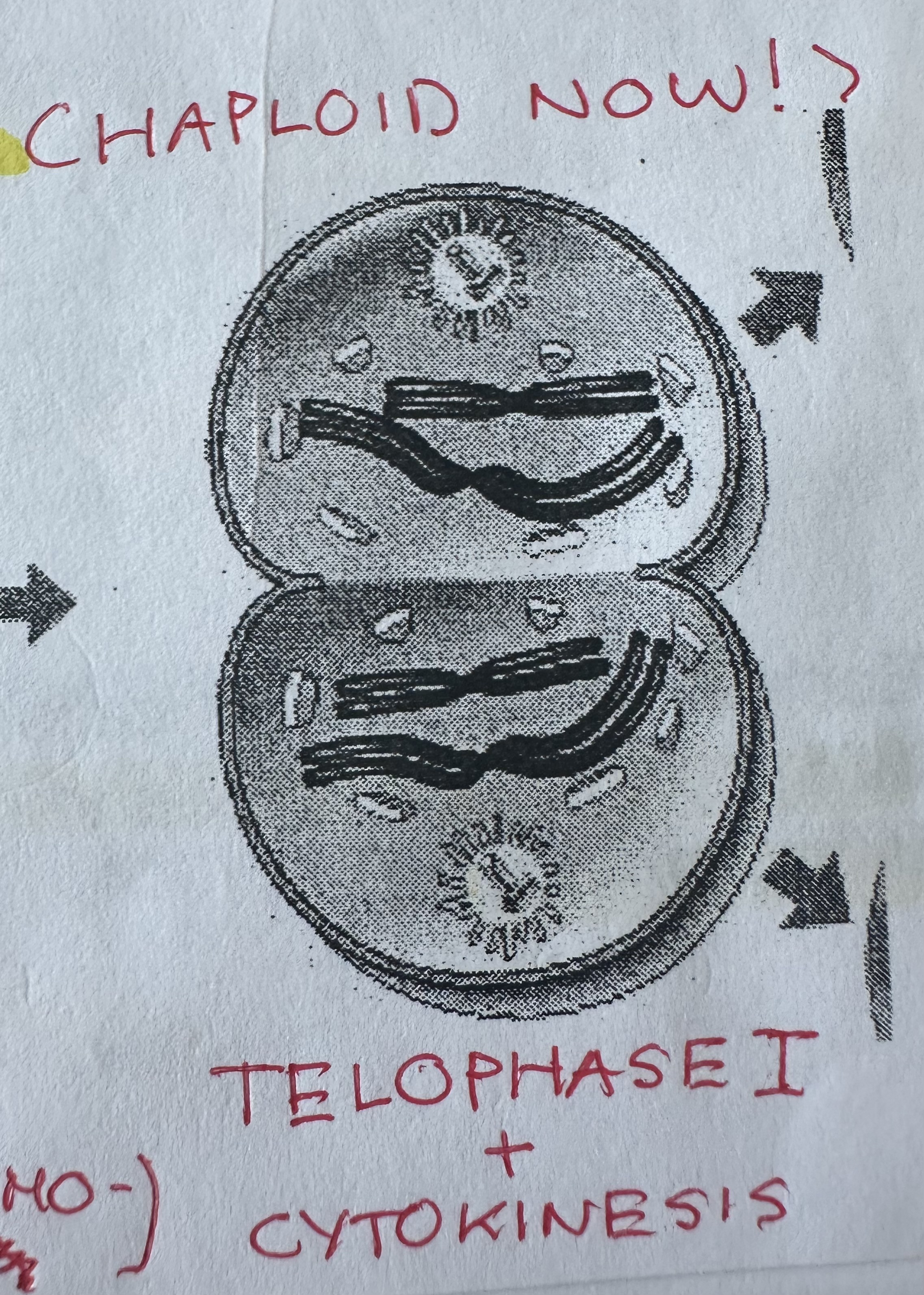
Meiosis I results in
each daughter cell have half # of chromosome in parent cell. One homologous chromosome of each homologous choromosomes pair in each daughter cell.
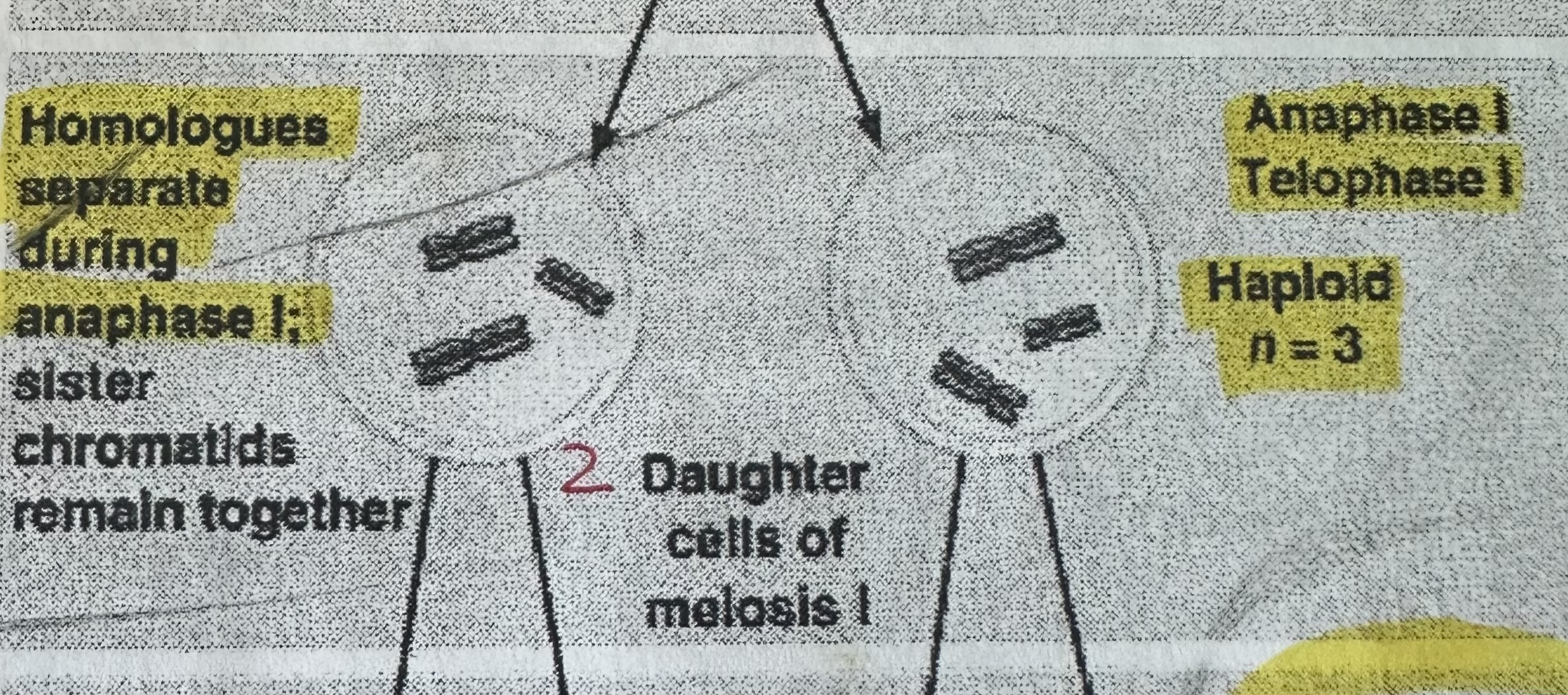
Meiosis II
meiosis I daughter cell undergoes another cell division, similar to mitosis but not preceded by DNA replication.
Meiosis II phases
Prophase II, Metaphase II, Anaphase II, Telophase II + Cytokinesis
Prophase II
Telophase I leads directly to prophase II
New set of spindle fibers form around chromosomes
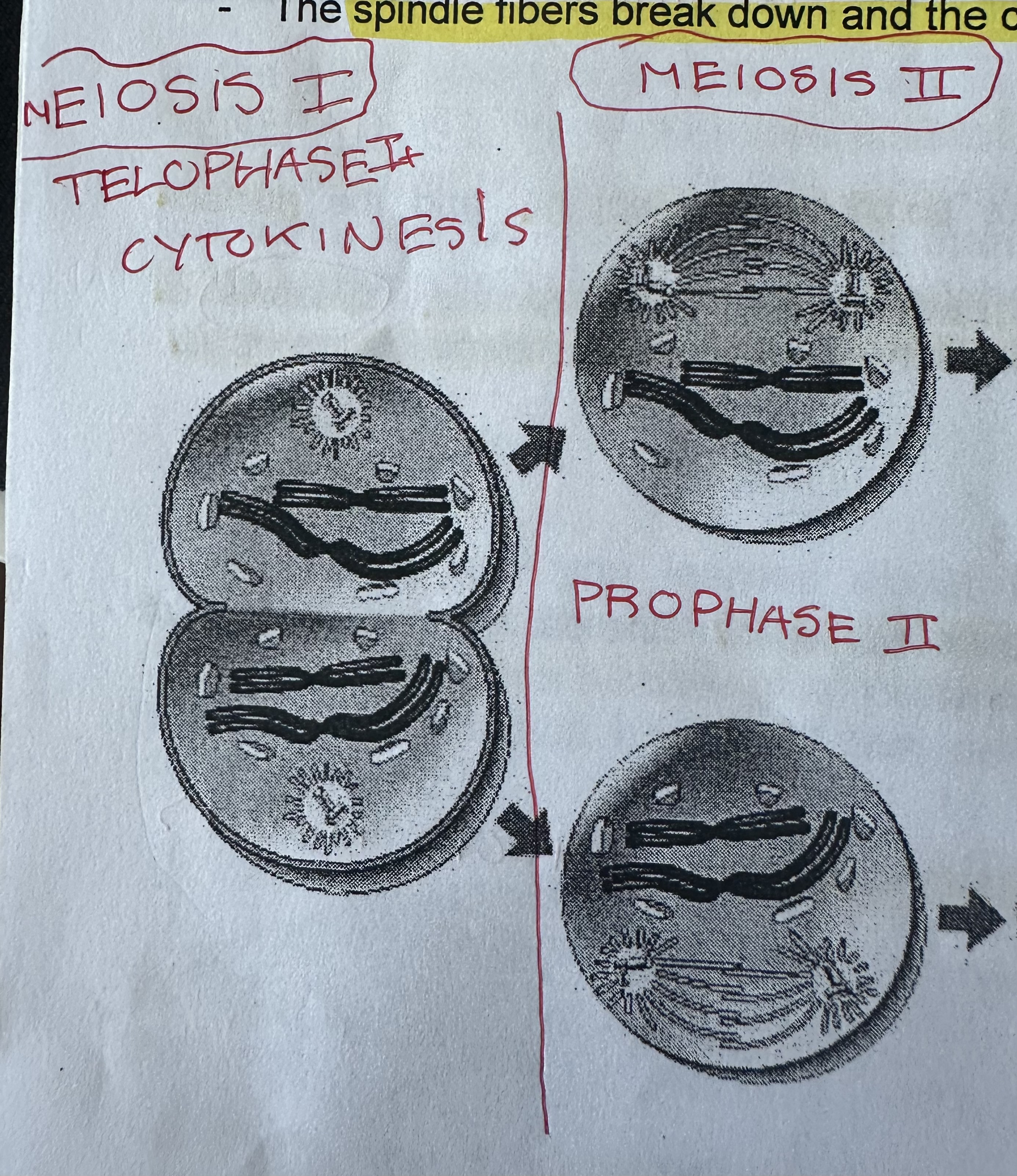
Metaphase II
Chromosomes line up along metaphase plate, attached at their centromeres to spindle fibers.
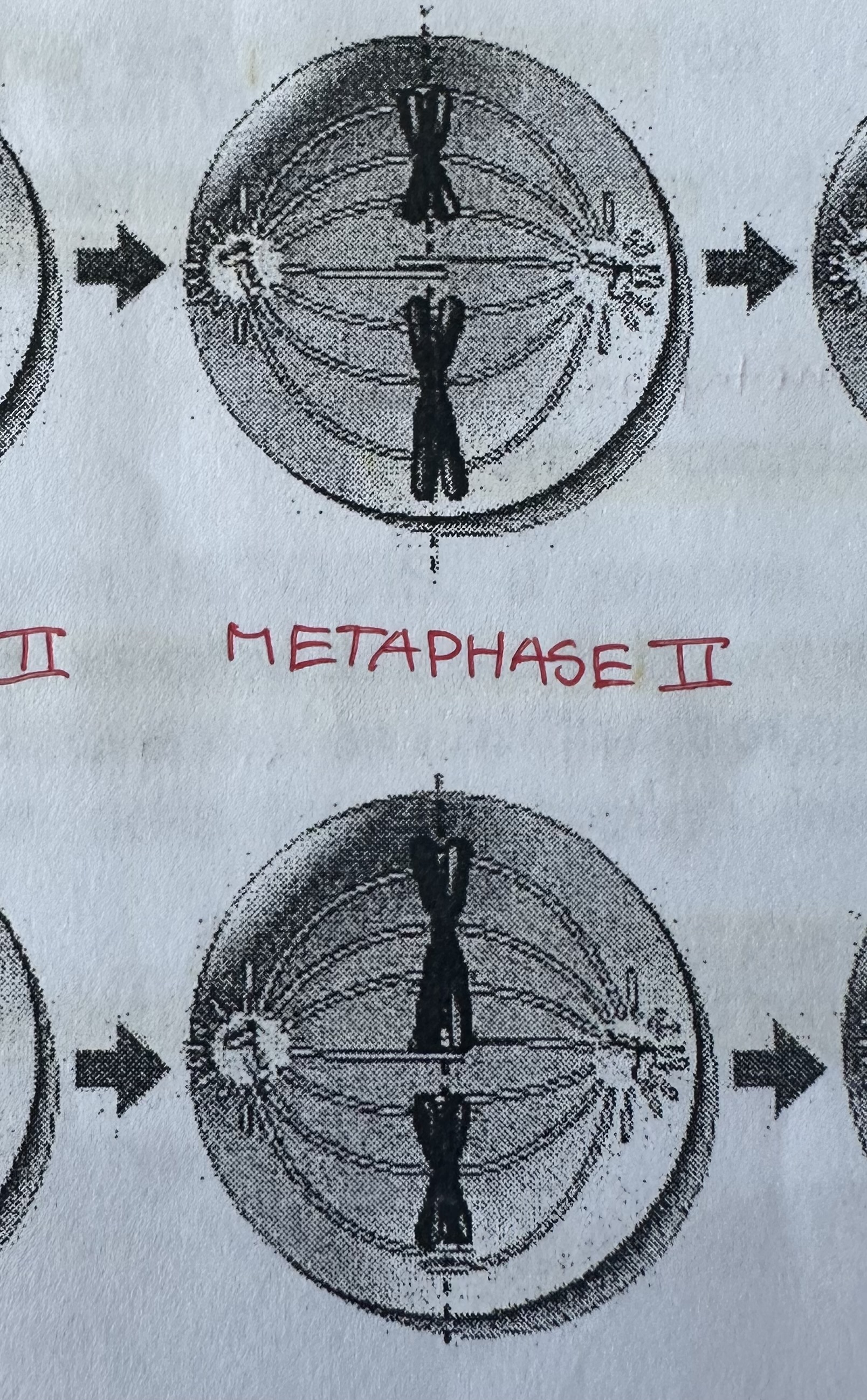
Anaphase II
Centromeres divide and sister chromatids seperate
Each sister chromatid becomes a new chromosome with its own centromere.

Telophase II
Nuclear membrane forms around each set of chromosomes.
spindle break down and cell undergoes cytokinesis.
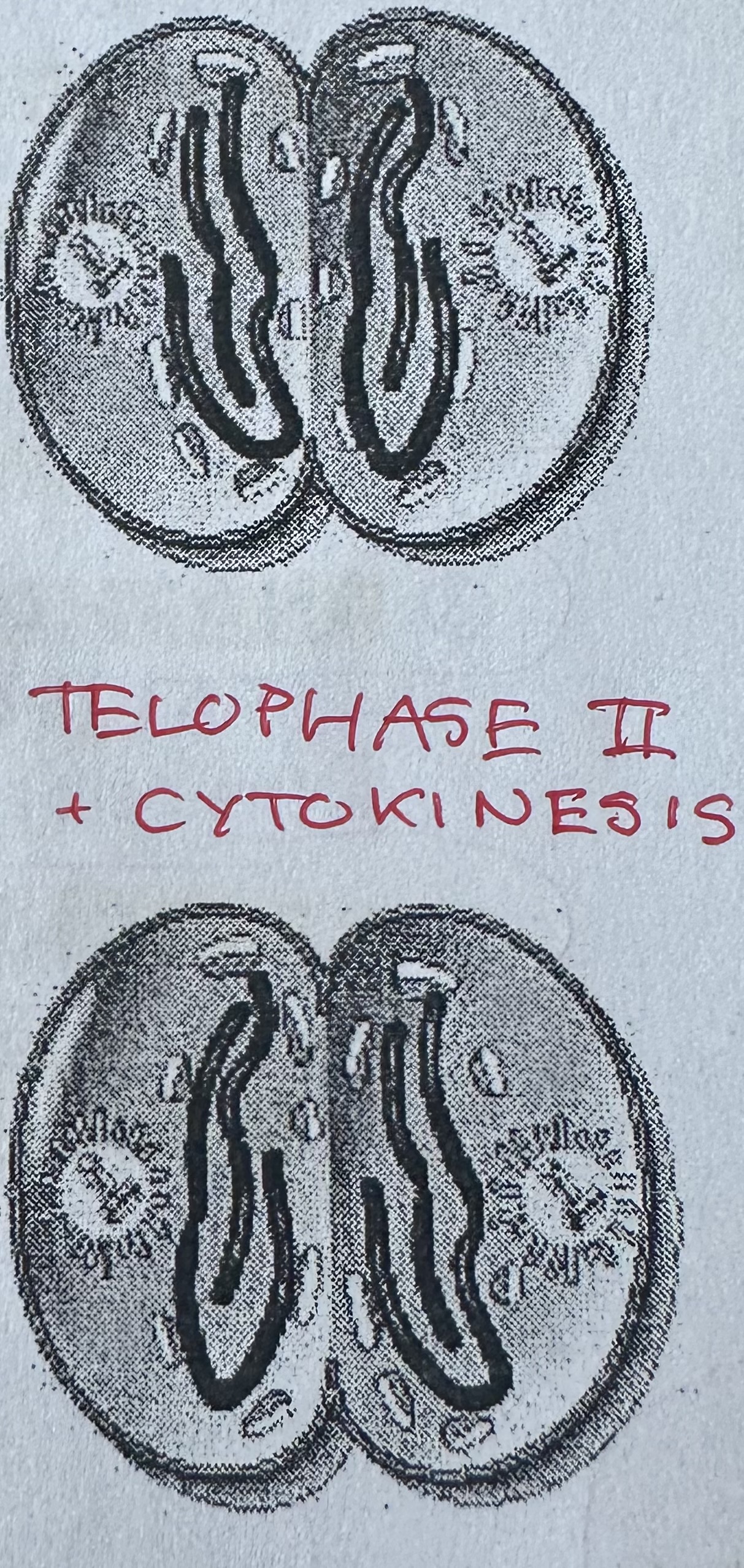
Meiosis II results in
total of four daughter cells produced. Each is a haploid (n) and unique genetically from other daughter cells and parent cell
Meiosis is different from mitosis 1
Meiosis = 4 daughter cells (2 divisions)
Mitosis = 2 daughter cells (1 division)
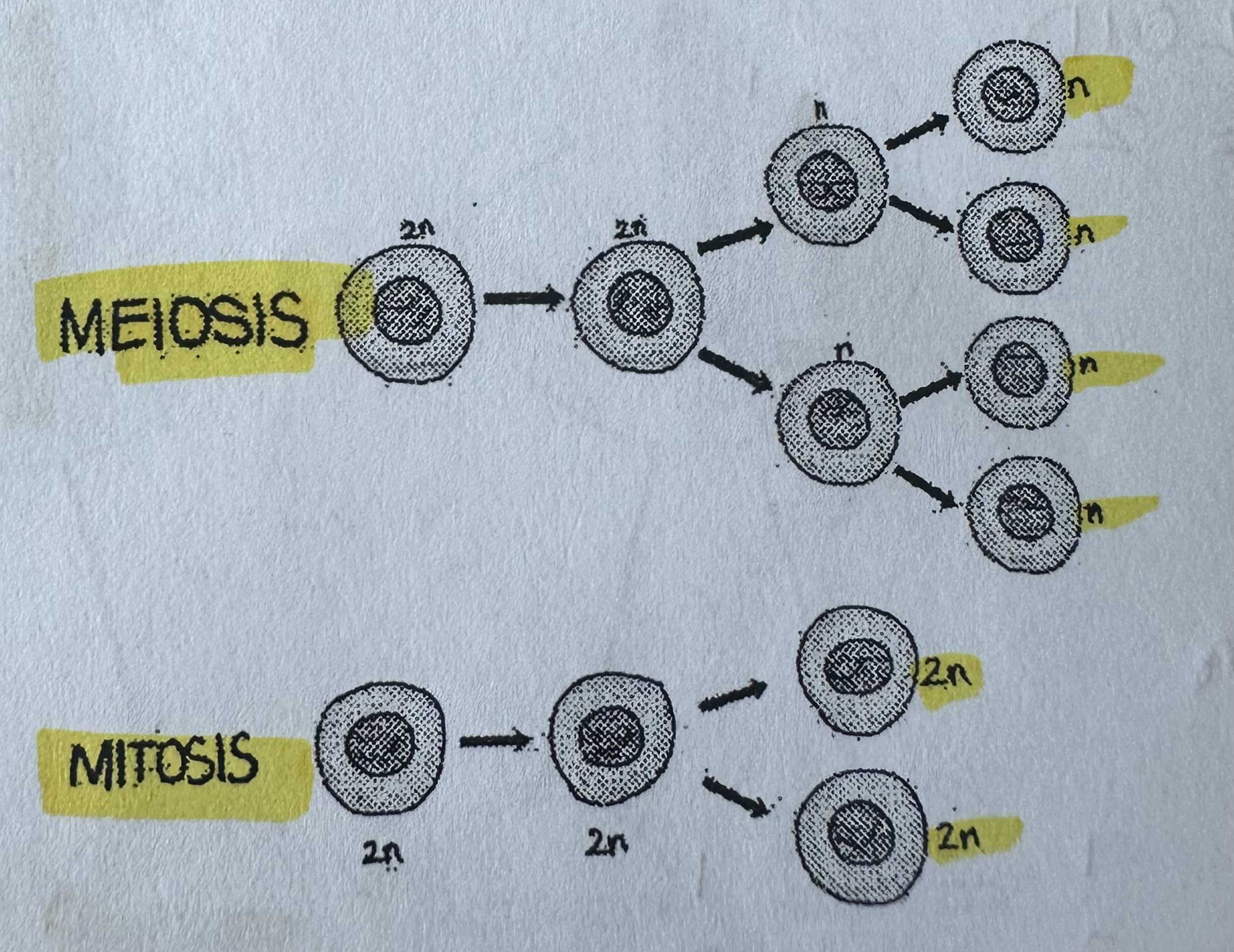
Meiosis is different from mitosis 2
Meiosis = chromosomes number is halved from diploid # (2n) to hapolid # (n) so that chromosome remain constant generation to generation
Mitosis = chromosome number is identical to parent cell (2n)
→ Haploid cells have one copy of each chromosome, while diploid cells have a homologous pair of each chromosomes.
Meiosis is different from mitosis 3
Meiosis = chromosomes are re-arranged to form new combinations of genes (genetic recombination) and is a major source of genetic variation. Million gametes that would all be unique.
Mitosis = daughter cells are genetically identical to parent cell
Meiosis two important roles
Keeps chromosome # constant from one generation to next. (Genetic continuity)
Ensure each generation have a different genetic make-up. provides means to shuffle and reorganize chromosomes. (Genetic variation)
Three mechanisms that contribute to genetic variation arising from sexual reproduction
Independent assortment of chromosomes, crossing over (recombination), and random fertilization.
Independent assortment
At metaphase I, random lining up of homologous chromosomes one maternal (mom) and one paternal (dad) create many possible gamete chromosomes combinations.
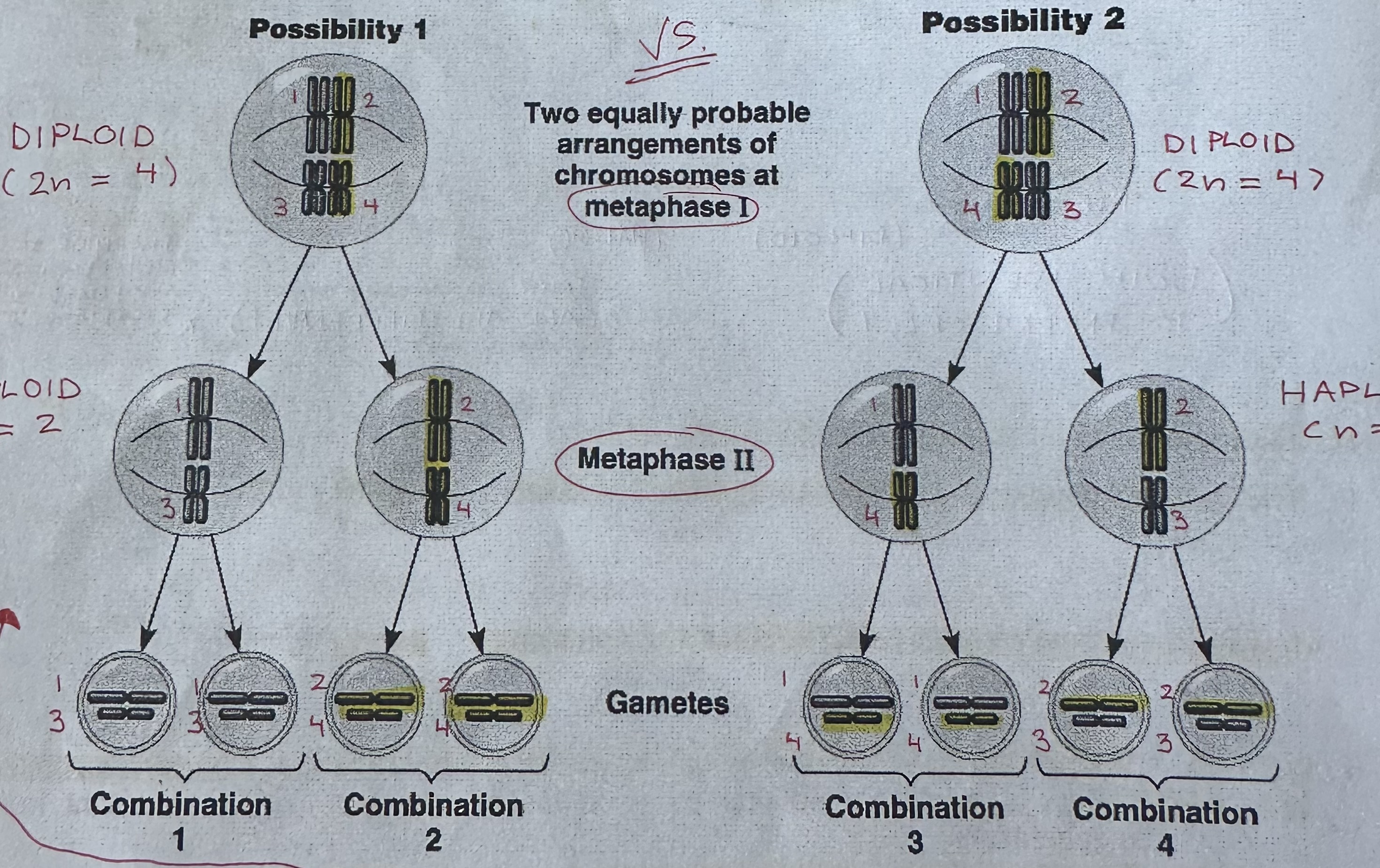
Formula 2 calculate total chromosome combination of gametes
2^n
n = haploid #
eg. human haploid # = 23
possible human gamete chromosome combination = 2²³ = 8,388,608
Crossing over
produces recombinant chromosomes during synapsis (early prophase I) an exchange of genetic material may occur between non-sister chromatids of a tetrad (in human avg. two-three crossevents per chromosome pair).
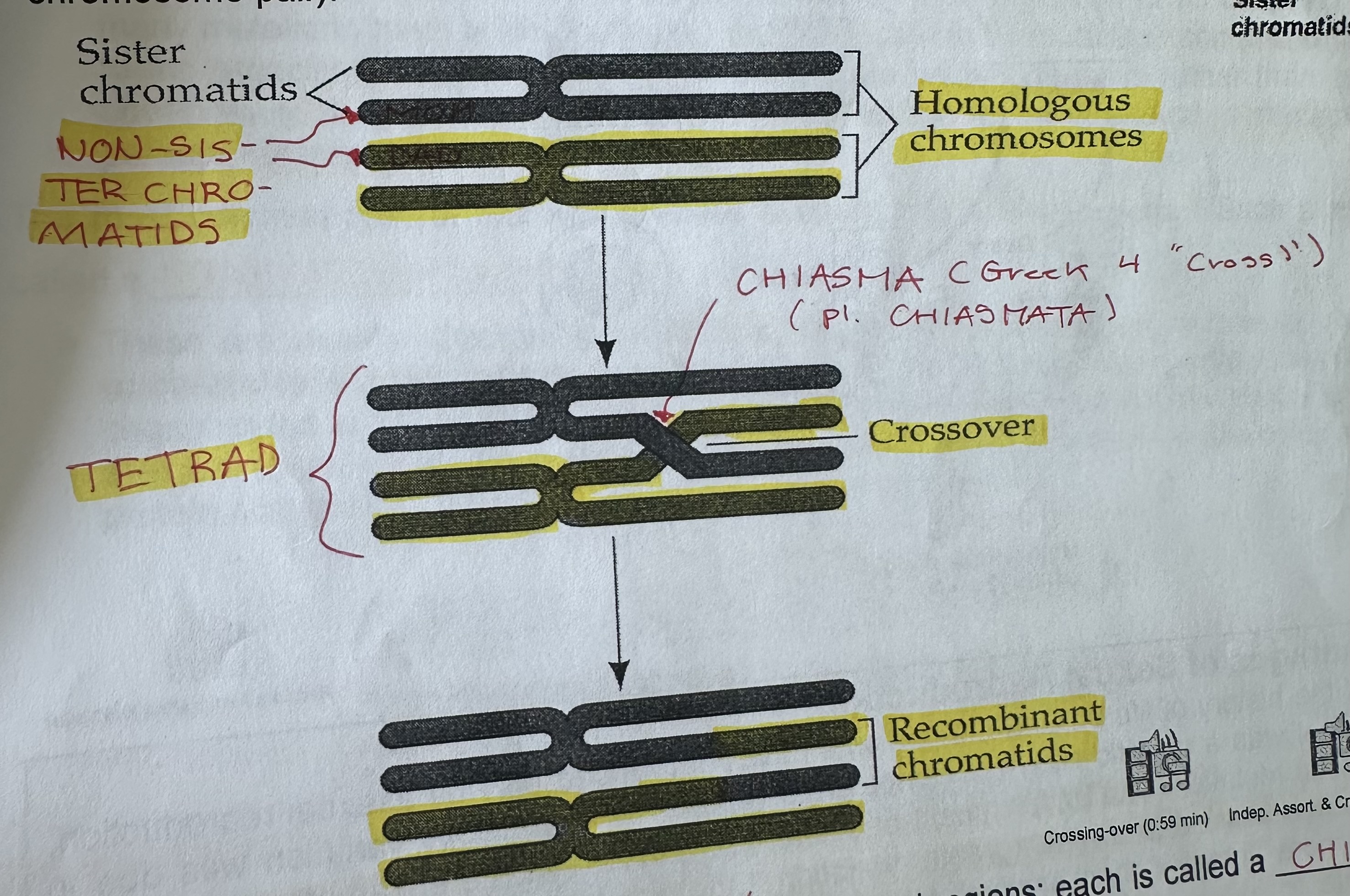
Crossing over results in
daughter cells receiving chromosomes with recombined genetic information.
Chiasma
pl. chiasmata
X-shaped, microscope visible region representing homologous chromatids that crossed over.
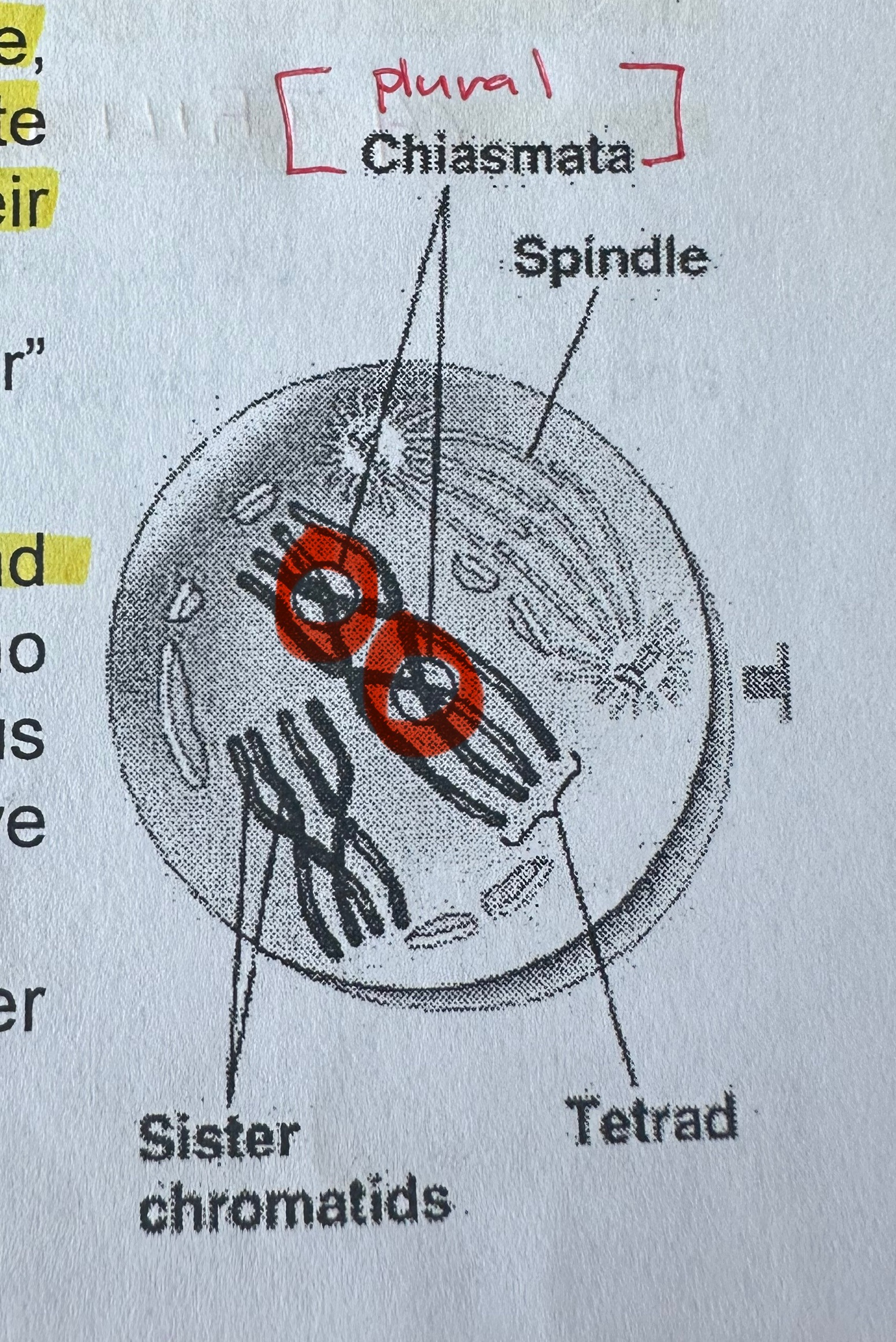
Random fertilization
adds to genetic variation
don’t know which chromosome combinations in sperm will fertilize which chromosome combination in egg.
total zygote (diploid) combinations
A human ovum representing one of approx. 8 million is fertilized by a sperm also representing one of approx. 8 million. Without crossing over any two parents will produce a zygote with any of approx. 64 trillion it would be even greater with crossing over.
Advantage of sexual reproduction
Introduce genetic variation that allows species to adapt to their environment and evolve. So advantaguous that almost all species sexually reproduce. Some do both (bees and citrus fruit)